



140 Years 140 Facts
2021 marked the 140th anniversary of the beginning of public education in the community of Edmonton.
To commemorate this anniversary, Historic McKay Avenue School, home of Edmonton Public Schools Archives and Museum, launched a project called “140 Years 140 Facts”. Over the course of 2021, we posted the following 140 facts about what is known today as Edmonton Public Schools.
Fact #1
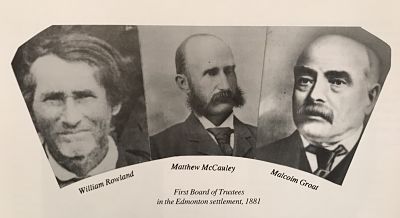
Our First Board of Trustees
Although there had been mission schools and private schools for many years in the settlement of Edmonton, by 1881 none were operating. Much interest was being generated in building a public school to ensure the education of the children of our settlement. In the fall of 1881, a meeting was held at Donald Ross’s Edmonton Hotel with the purpose of hiring a Board of Trustees. William Rowland, Matthew McCauley and Malcolm Groat were elected as the first Board of Trustees of the Edmonton settlement. They quickly began work on organizing the building of what was to become the first free public school in what is now the province of Alberta. The school was built in December of 1881 and classes began on this day, January 3, in 1882.

Fact #2

Matthew McCauley
Not only was Matthew McCauley one of the first three school trustees, he became the first mayor of Edmonton, a member of the legislative assemblies of the Northwest Territories and Alberta, and the first warden of Edmonton’s first federal prison.
Photo credit: City of Edmonton Archives EA-10-1565
Fact #3
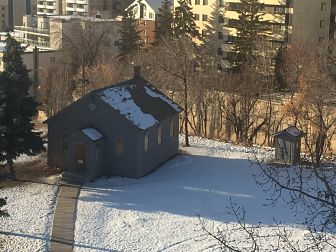
1881 vs. 2021 Construction Costs
The cost of Edmonton’s first public school, built in December 1881, was $968 (roughly $26,000 today). In 2021 a new school will cost in the 10s of millions.
Fact #4
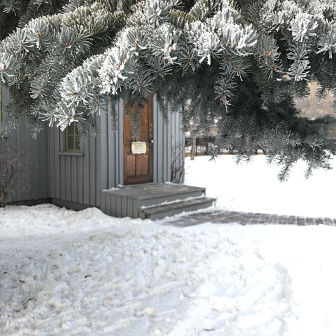
Specifications for the 1881 Schoolhouse
The 1881 Schoolhouse was the first frame lumber building to be constructed in the settlement of Edmonton. Specifications included a porch and double front doors.
Fact #5

The First Desks
The first desks in the 1881 Schoolhouse were made from spruce trees cut down in the river valley. The youngest students would sit four to a form (bench). The desks in the photo are replicas of the original desks.
Fact #6

1881 Schoolhouse Windows, Part One
The 1881 Schoolhouse had 8 windows containing panes of glass measuring 10”x14”. These were the largest in the community at the time.
Fact #7
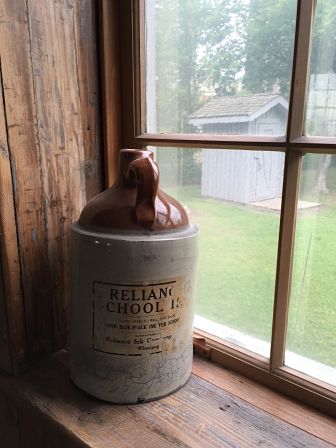
1881 Schoolhouse Windows, Part Two
The glass for the windows in the 1881 Schoolhouse was shipped from Ontario. In order to keep them from breaking, the panes were put into barrels of molasses. There is a story that when the glass arrived, the children of the settlement were invited down to Fort Edmonton and they licked the glass clean!
Fact #8
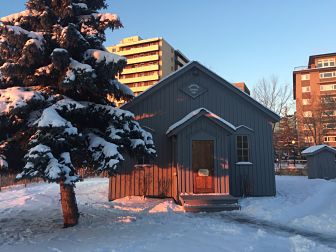
1882 Stats
On January 3, 1882 “Edmonton Public Schools” consisted of 1 school, 1 teacher, and 28 students (25 boys and 3 girls). On September 30, 2020 Edmonton Public Schools consisted of 214 schools, over 9500 staff and 103,655 students.
Fact #9
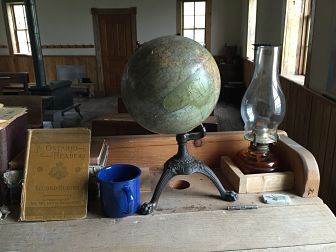
James Harris
The first public school teacher in Edmonton was James Harris. Unfortunately, he only taught for 6 weeks when he became ill, passing away from stricture about six weeks later at the age of 38. Sadly, we are not in possession of a photo of our first teacher.
Fact #10
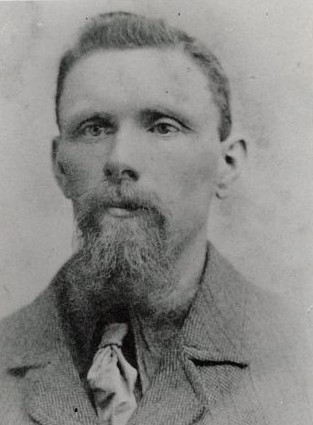
Edward Langrell
Edward Langrell was the second teacher in the 1881schoolhouse. Educated in Dublin, Ireland he emigrated to Canada in 1874. In 1880 he walked from Winnipeg to Edmonton, a trek of over 6 weeks. It is reported that “The boys were very afraid of him. He was very strict.” Langrell resigned his position after only 5 months to return to Manitoba. His wife had refused to stay in Edmonton as she considered it no place for a civilized woman.
Fact #11

Major William Stiff
Edmonton’s 3rd teacher was Major William Stiff, a retired army officer who ran an Edmonton real estate agency. Although he had no formal teacher training he was allowed to teach on a temporary permit. Being extremely strict, his students referred to him as “Old Stiff”.
Photo credit: Provincial Archives of Alberta B2025
Fact #12
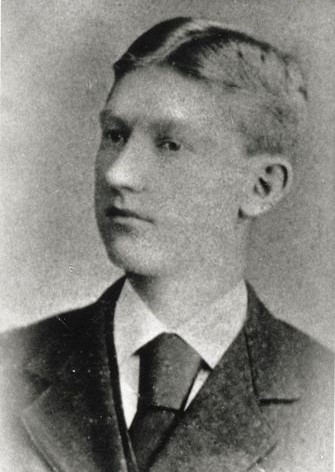
Richard Secord
Richard Secord was to become the 4th Edmonton teacher in the spring of 1883. Having arrived in Edmonton in 1881 he had actually helped build the 1881 Schoolhouse. He was a popular and effective teacher, teaching for 3 years. He lost his job in February 1886 when he failed in his bid for a pay raise of $5 to $80/month.
Photo credit: Edmonton Public Schools Archives and Museum P91.27.1
Fact #13

Patriotic Exercise
On January 31, 1941 Alberta school trustees passed a resolution based on a proposal submitted by Edmonton Public School Board Trustees. It encouraged the provincial government to require some form of patriotic exercise such as saluting the national flag, which at that time was still the British Union Jack. For more on this story go to https://edmontonjournal.com/news/local-news/jan-31-1941-alberta-trustees-want-compulsory-saluting-of-flag-in-schools
Fact #14
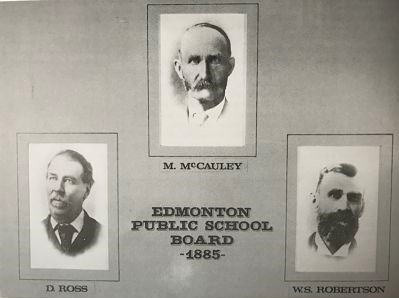
Edmonton Protestant Public School District No. 7 (1885)
On February 3, 1885 the School District of Edmonton of the Northwest Territories, Protestant Public School District #7 was created. This was the result of a hotly contested debate in Edmonton as many citizens were opposed to the taxation that would result. It did help with the ongoing financial problems of operating the school.
Fact #15
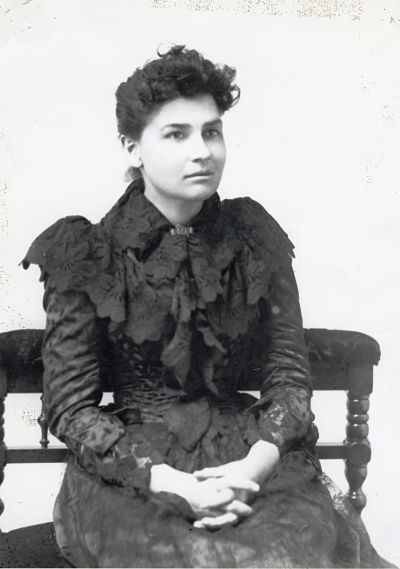
First Female Teacher
Did you know that the first female teacher was hired by Edmonton Public Schools in 1889? Lillian Osborne, daughter of the local postmaster, was employed for over 30 years, and taught at McKay Avenue School, Old Queen’s Avenue School, Delton School, and Glenora School. Today, there is a school named after her.
Photo credit: Provincial Archives of Alberta B8353
Fact #16
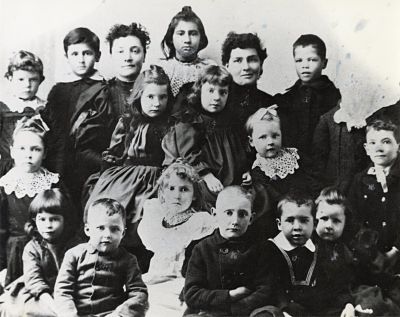
Female Teachers 1889-1946: Imposed Societal Expectation and Lower Wages
Lillian Osborne with students circa 1890. Miss Osborne was to remain a single woman all her life. At this time, only single females were engaged for regular teaching duties and any female teacher who was married while in the employ of the Board was forced to resign. From 1889 to 1946 there was a substantial difference in the salaries of male and female teachers with the same teaching qualifications. Lillian Osborne died on November 3, 1929 while still on staff at Glenora School. She was 60 years old and had dedicated almost 40 years of her life to teaching.
Photo credit: Edmonton Public Schools Archives and Museum P95.88.1
Fact #17

Edmonton Technical School Science Lab
Tomorrow is International Day of Women and Girls in Science. Today’s photograph, taken sometime between 1913 and 1923 of only male students in Edmonton Technical School’s science lab, is a reminder of how much more inclusive education is today in Edmonton Public Schools. Today, you will find a strong focus on gender inclusivity and promoting female students in science, technology, engineering, and math courses.
Photo credit: Edmonton Public Schools Archives and Museum P85.5.25
Fact #18

Mandarin Bilingual Language Program
Happy Lunar New Year! In 1984 students at Alex Taylor School celebrated the New Year with a dragon dance! Did you know the Mandarin Bilingual Language Program was approved by the Edmonton Public School Board in February 1983? Today, this school program is being offered at 15 Edmonton Public Schools.
Photo credit: Edmonton Public Schools Archives and Museum P95.78.3
Fact #19
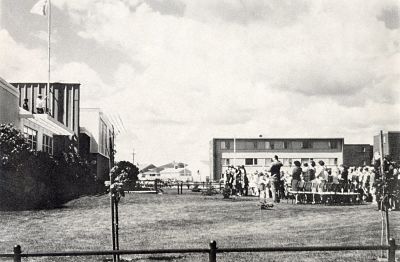
Flag Day
Yesterday was FlagDay! In Canada, this day commemorates the inauguration of the Canadian Maple Leaf. It replaced the British Union Jack and Canadian Red Ensign as Canada’s national flag on February 15, 1965. Pictured are students at McQueen School taking part in a ceremony in June of 1965 raising the Maple Leaf flag.
Photo credit: Edmonton Public Schools Archives and Museum P85.17.33
Fact #20
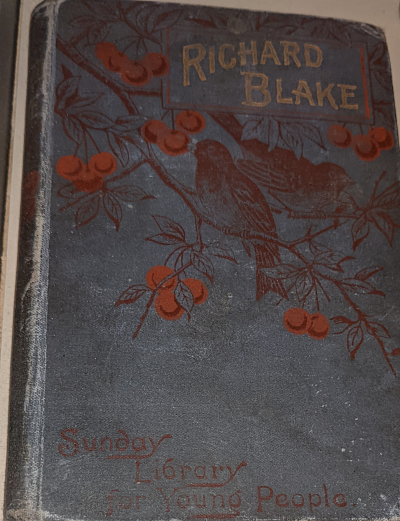
Book Prize 1886
February 14 was International Book Giving Day. In 1886, when Lieutenant-Governor Dewdney of the North-West Territories visited Richard Secord’s class, he was so impressed that he gave ten books to be used as prizes for student achievement. Ten year old Alex McCauley won the book pictured. The inscription inside the book can be seen in the second picture.
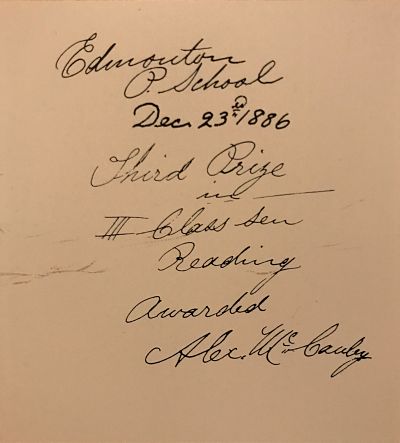
Fact #21
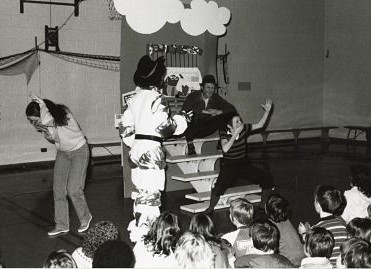
Languages
February 21 is International Mother Language Day. Many of the past and present newcomers to Edmonton have a strong desire for their children to be fluent in their mother language. In 1959, Edmonton Public Schools introduced oral French classes in twelve Grades 4, 5, and 6 classrooms. Since then our Division has drastically expanded language programming to include American Sign Language, Arabic, Cree, French, German, Hebrew, Japanese, Latin, Mandarin, Punjabi, Spanish, and Ukrainian.
Pictured is the French theater troupe, Boîte à Popicos, performing at Holyrood School (unknown year).
Photo credit: Edmonton Public Schools Archives and Museum P95.78.136
Fact #22
.jpg)
“Rules for the Guidance of Parents and Pupils” 1888
In 1888 the first “Rules for the Guidance of Parents and Pupils” were adopted by the Board of Trustees. These rules covered the hours of operation, how to provide consent for students to leave school early for a day, and how to address damage to property.
Source: Edmonton School District No. 7 Minutes (Edmonton Public Schools Archives and Museum 85.129.2)
.jpg)
Source: Kostek, M.A., A Century and Ten: The History of Edmonton Public Schools (Edmonton, Alberta: Edmonton Public Schools, 1992) 43.
Fact #23
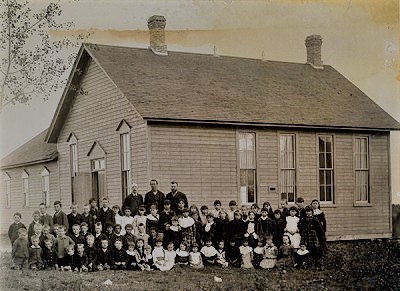
First Principal
By 1888 the student enrollment of the 1881 Schoolhouse had grown to 82 pupils. A 28’ by 36’ addition was deemed necessary and approved for construction. James McDonald, who built the original school, was the successful bidder at a cost of $1,550. Along with the new school addition, the purchase of 24 desks was authorized.
James Martin, who was the present teacher, became Edmonton Public Schools first principal. A second teacher was required and Major Stiff made a reappearance at a salary of $50/month. He remained for one year before he was let go by the Board.
Photo credit: City of Edmonton Archives EA-10-910
Fact #24

Night School Classes
In 1890 Principal Martin agreed to introduce a night school program, which ran three evenings a week to cater to young people who could not attend day classes. He also convinced the Trustees to add a belfry and to erect a fence to keep horses from grazing in the schoolyard.
In 1891 a third classroom was added to the schoolhouse and a third teacher was hired. The new teacher, Janet Henderson, earned $450 per year at this time. With the addition of a third classroom, the caretaker’s salary was raised to $100 per year.
Photo credit: Provincial Archives of Alberta B3886
Fact #25
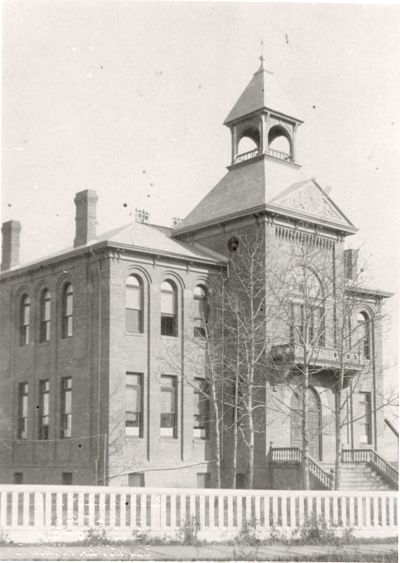
College Avenue School: Our First High School
Built in 1895, College Avenue School, containing four classrooms, was Edmonton Public Schools first brick school. A coal furnace and electric lighting were some of the modern features of the school. When it first opened, the school provided elementary and high school instruction. Before the end of 1896 it was discovered that, in addition to other structural problems, the building had been built on the site of an abandoned coal mine and was slowly sinking into the ground. Many efforts were made to remedy this problem.
Photo credit: Edmonton Public Schools Archives and Museum P85.7.2
Fact #26

High School Class 1904
From 1903 to 1911, College Avenue School was used exclusively for high school classes and was casually referred to as Edmonton High School. Despite the crumbling foundation and cracking walls and floor, classes continued until a new high school building was completed in 1911. College Avenue School was demolished in 1918. It was located along what is now Macdonald Drive near the present day location of the Telus building.
Photo credit: Edmonton Public Schools Archives and Museum P85.7.1
Fact #27
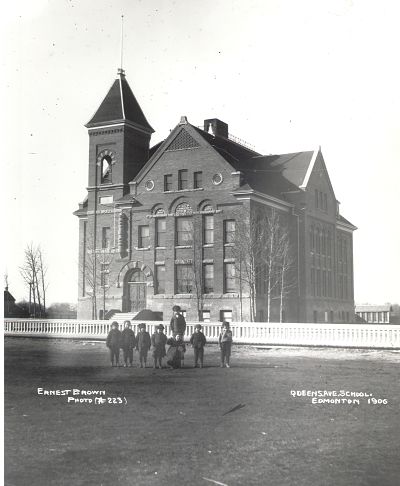
Queen’s Avenue School
Queen’s Avenue School opened in 1903. It had 10 classrooms and was built to accommodate 500 students. When construction began, people wondered why it was being built in the bush on the outskirts of town. If still standing today, it would be on the west side of the Royal Alberta Museum! In 1905 the Canadian Northern Railway line reached Edmonton and the tracks were 30 metres north of the school creating both noise and safety problems.
Photo Credit: Provincial Archives of Alberta B3882
Fact #28
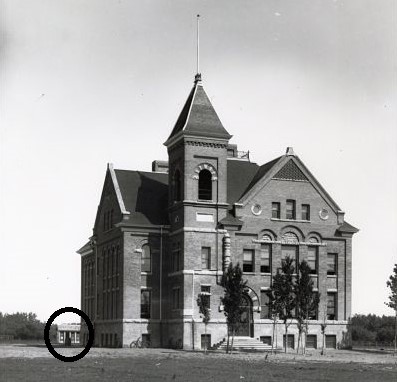
Indoor Plumbing at Queen’s Avenue School!
Tomorrow, March 11, is World Plumbing Day so it is only fitting to do another post about Queen’s Avenue School. If you look closely at today’s photo and the previously posted photo, you can see the row of outhouses behind the school. These were of course a necessary fixture at schools. In 1904, much to the delight of students and staff, indoor plumbing was installed and Queen’s Avenue School became the first Edmonton Public School to have indoor washrooms.
In our previous post, we mentioned that the arrival of the railroad brought with it both noise and safety problems. Despite this, Queen’s Avenue School was used until 1926 when it was sold to the railroad company and eventually demolished in 1949.
Photo Credit: Provincial Archives of Alberta B3901
Fact #29
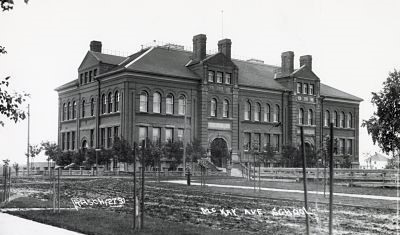
McKay Avenue School: Then & Now
Of the 36 public schools built prior to 1921 half of them are still standing and continue to serve our community. We will be featuring these centenarians over the next several weeks.
Built in 1904, McKay Avenue School is now the oldest brick school still standing in Alberta. It was named after Dr. William MacKay, who worked for the Hudson’s Bay Company until 1898 when he opened a private practice in Edmonton that he ran for 19 years. The road in front of his house was named in his honour but it was spelled “McKay” Avenue. Subsequently, the name of the school was also spelled incorrectly. When Alberta became a province in 1905, our government met for the first two sessions on the third floor of the school. In 1912, a four room addition and second front entrance was added.
McKay Avenue School closed in June 1983. Already a Provincial Historic Site, it was saved from demolition and lovingly restored, partially with the assistance of students from W.P. Wagner School. Today it is a public archives and museum. In addition to facility rentals and self-guided tours for the public, the educational programs in the two historic landmarks help to give students a sense of place and history.
Photo credit (b&w image): Provincial Archives of Alberta B3862
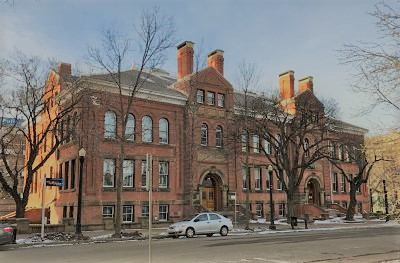
Fact #30

Early Arithmetic Textbook
March 14, was the International Day of Mathematics. The Dominion School Arithmetic textbook was published in 1908 and authorized for use in Alberta 1912-1922 in Grades 7 and 8. It would have been one of the earliest authorized resources utilized by Edmonton Public Schools.
The second photo comes from the review section at the beginning of the book so it would seem reasonable to think that a student leaving grade 6 would be capable of doing these questions. Anyone care to give the problems a go?
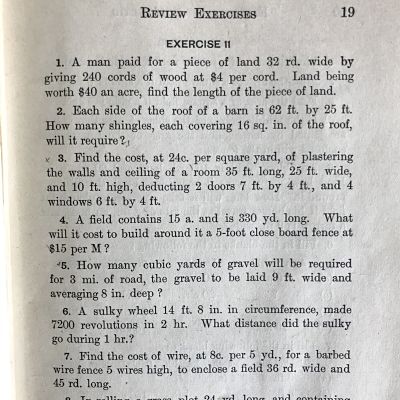
Fact #31
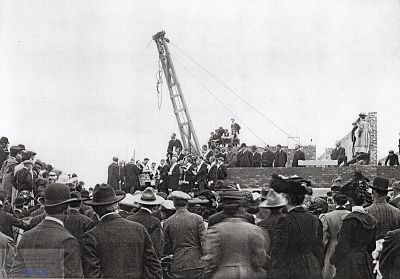
Alex Taylor School: Then and Now
Alex Taylor was the first of only a handful of Trustees in the history of Edmonton Public Schools to have the honour of a school being named after them while serving as an elected official. The cornerstone for Alex Taylor School was laid in a colourful ceremony in August 1907 and the school opened in March of 1908. In 1914 a program was launched at Alex Taylor School, and one other school, to provide lunches to the children of impoverished families. The cost for pupils able to pay was 2c for a cup of milk and 1c for each slice of buttered bread. Children unable to pay were provided with a free lunch. The school closed in 2001. Today it serves as the centre for Edmonton City Centre Church Corporation (E4C). E4C delivers multiple programs in adult literacy, hot lunch programs and family counselling services.
Photo credit: Edmonton Public Schools Archives and Museum P85.3.26 and P85.3.23
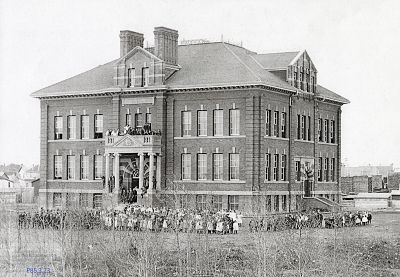
Fact #32
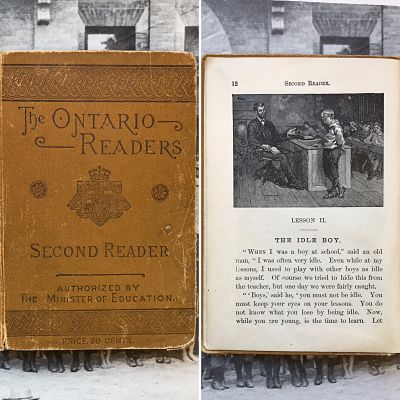
Early Reading Textbooks or “Readers”
Today is International Read to Me Day. Through the years many “Readers” have been used in Edmonton Public Schools. Today we are sharing three (3) of these books spanning 86 years.
1) The Ontario Readers: Second Reader was used for Standard 2 which is equivalent to Grade 3 and 4. It was authorized for use from 1890 - 1907. Many of the stories were meant to teach a moral lesson.
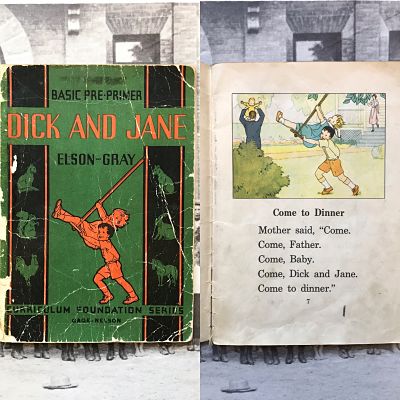
2) Dick and Jane Basic Pre-Primer would have been beginning Grade 1 and was used from 1939 - 1946.
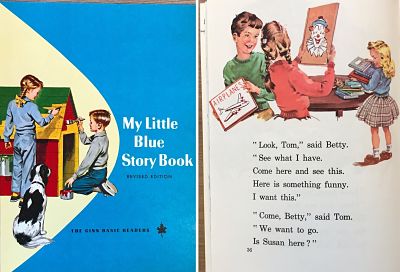
3) My Little Blue Story Book was also a pre-primer. It was an authorized text from 1957 - 1976.
Fact #33
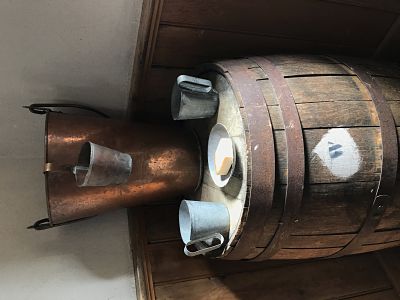
The Water Bucket
In the first decade of the 1900s Edmonton was experiencing a rapid growth in its student population. Several temporary schools were hastily built: Norwood Extension and Syndicate Avenue North and South were built in 1906. While the students at Queen’s Avenue, McKay Avenue and Alex Taylor schools were enjoying running water and indoor toilets, students at the temporary buildings still had to be content with water buckets, dippers and outhouses. In the summer water would be delivered by the water wagon and stored outside in large wooden barrels and in the winter could be obtained from melting snow.
Fact #34
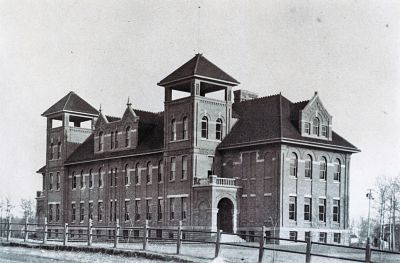
Queen Alexandra School: Then & Now
Queen Alexandra School, being on the south side of the river, was built in 1906 by the Strathcona School District #216 and was originally named Duggan Street School. In 1908, the third floor assembly hall served as a temporary lecture hall to 45 students attending the newly formed University of Alberta. It was renamed Queen Alexandra School in honour of the wife of King Edward VII in 1910. When Edmonton and Strathcona amalgamated in 1912 it became part of Edmonton Public Schools. A large addition was completed in 1913. Today, Queen Alexandra School continues to serve the community as an elementary school and offers both the Logos Christian Program and French Immersion.
Photo credit: City of Edmonton Archives EA-10-3052
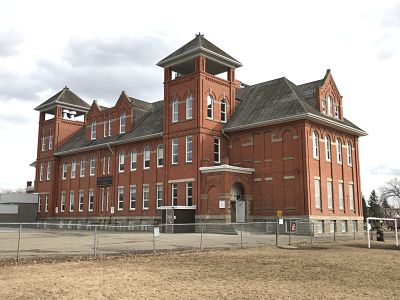
Photo credit: B. Christy
Fact #35

Old Scona School: Then & Now
Another school that started off as part of the Strathcona School District is Old Scona. When construction began in 1907, the Strathcona Collegiate Institute was described as the best equipped school in Alberta. It was the first high school built on the south side. In 1913, the name was changed to Strathcona High School. Old Scona has served a variety of purposes. In 1958 it ceased to be a high school and until the mid ‘60s it housed junior high classes. Later it served as a special education school, a continuing education center for adults and an annex of Grant MacEwan Community College. In 1976, Old Scona reopened as an academic high school. Today, Old Scona Academic School continues to prepare its students for post secondary, just as it did back when it first opened. The academic program has been in place for 45 years and continues to see Old Scona ranked as the top public high school in Alberta.
Photo credit: Provincial Archives of Alberta B3845

Photo credit: B. Christy
Fact #36
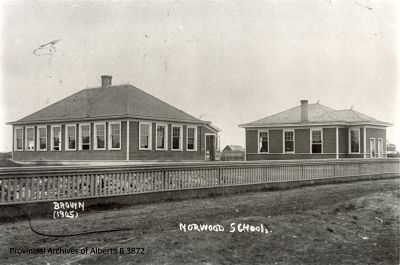
Norwood School: Then & Now
The beginning of Norwood School was in two temporary wooden buildings that were constructed in 1906. Some parents objected to the location of the school, due to the close proximity of piggery, a nuisance grounds (garbage dump) and a slaughterhouse. The school was even referred to as Rat Creek School, due to the creek flowing south of the buildings, before the name Norwood School was formally chosen. These temporary buildings were last used in 1914.
Photo credit: Provincial Archives of Alberta B3872

In 1908, construction began on the present day Norwood School and the official opening was February 26, 1909. At this time, enrolment in the temporary Norwood School buildings was averaging 51 students per room. A year previous, the Trustees had been criticized for building such an expensive school in the “wilderness”!
Photo credit: Edmonton Public Schools Archives and Museum P85.8.30
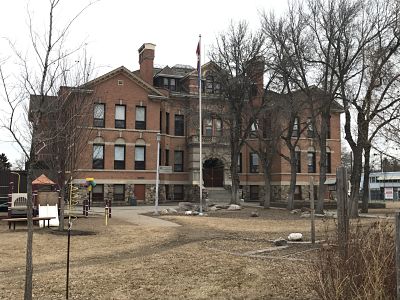
Today, Norwood School continues to serve a diverse community as a Kindergarten to Grade 6 school with a variety of programs. Part of the school philosophy is to create a culture of empowered, expressive and joyful learners.
Photo credit: B. Christy
Fact #37
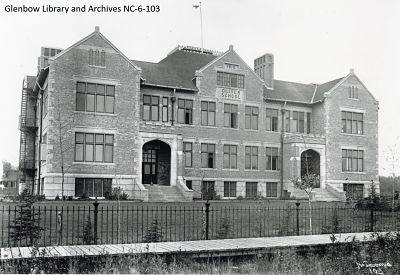
Oliver School: Then & Now
Due to the rapid population growth in Edmonton there was a boom in school construction from 1910-1913. Oliver School was the first school built during this boom. Construction of the school was completed in 1910 and the official opening was March 31, 1911 - exactly 110 years ago today! Each of the 12 classrooms was designed to hold 50 students. A miniature rifle range was incorporated into the design of the school and was eagerly eyed by scores of school cadets. Two teachers: Miss Robina McMillan and Helen Raver were on the Oliver staff for a total of 85 years (from 1919-1962 and 1922-1964 respectively)!
Today, Oliver School continues to serve the local community as an elementary school, including French Immersion, as well as the wider Edmonton community with the Nellie McClung Girls’ Junior High Program.
Photo credit: Glenbow Library and Archives NC-6-103
Fact #38
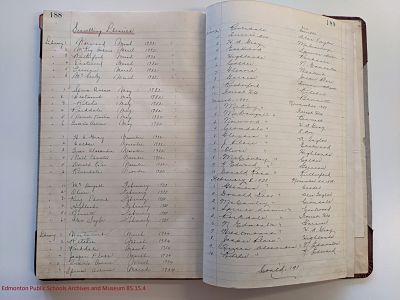
Travelling Libraries
April 7 is National Bookmobile Day. Similar to a bookmobile, Edmonton Public Schools operated travelling libraries in the early part of the 1900s. The featured book “Echoes” was part of one such travelling library. As can be seen from the ledger, there were several libraries that were sent to various schools for a period of two months. It was not until the second half of the 1900s that libraries were included in all new schools.
Source Credit: Edmonton Public Schools Archives and Museum 85.15.4

Source credit: Edmonton Public Schools Archives and Museum 2010.13.2
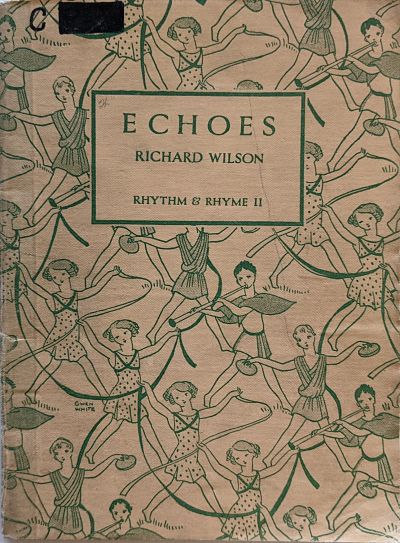
Fact #39

Libraries in Schools
This week has been National Library Week. In 1955, Edmonton Public Schools Board of Trustees approved a policy of including library rooms in all new schools and additions. A year later, a program of converting extra classrooms to libraries began. Pictured is the W. P. Wagner School library in the early 1980s.
Photo Credit: Edmonton Public Schools Archives and Museum P96.55.16
Fact #40
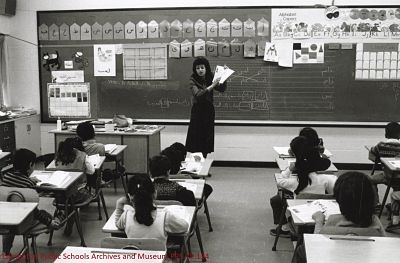
Arabic Bilingual Language Program
Today marks the beginning of the month of Ramadan for Muslim people around the world. A language synonymous with this celebration is Arabic. In 1983, Edmonton Public Schools launched an Arabic bilingual language program at Glengarry School. Pictured are students receiving Arabic language instruction at the school in the fall of 1983. Today the program operates in four elementary schools, two junior high schools and one high school (Queen Elizabeth School).
Photo Credit: Edmonton Public Schools Archives and Museum P95.78.134
Fact #41
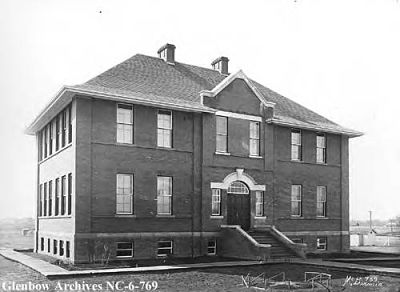
Rutherford School: Then and Now
Another large school operating in the city of Strathcona at the time of amalgamation was Rutherford School. It was, of course, named after Alberta’s first Premier. The four room school was built on land originally owned by the Rutherford family and opened in 1911. Students came from an area marked by Whyte Avenue to the south, the edge of the river valley hill to the north, the city limits to the east and Mill Creek Ravine to the west. Maude Bell was principal from 1911-1941 and was extremely resourceful. When she could not obtain sports equipment from the Board, she had the field to the west of the school plowed. The students planted potatoes in the spring, tended to them throughout the summer and harvested them in the fall. The potatoes were sold for enough money to buy the sports equipment. Today Rutherford continues to serve the community as a Kindergarten to Grade 6 school.
Photo Credit: Glenbow Archives NC-6-769
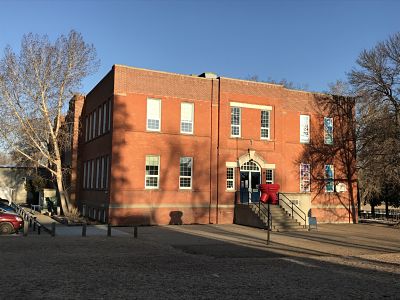
Photo Credit: B. Christy
Fact #42
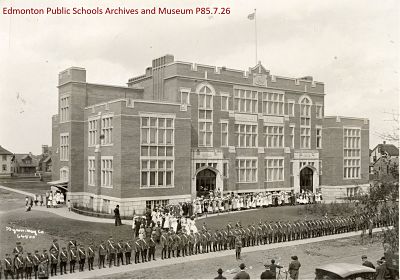
McCauley School: Then and Now
Named after Matthew McCauley, one of the driving forces behind the establishment of the first free public school in Edmonton, McCauley School officially opened on March 7, 1912. The school featured separate boys and girls entrances. As was typical of school construction at that time, the assembly hall, which also served as the gymnasium, was on the third floor. McCauley School closed in 2010. It continues to serve the community as the home of the Edmonton Intercultural Centre.
Photo Credit: Edmonton Public Schools Archives and Museum P85.7.26
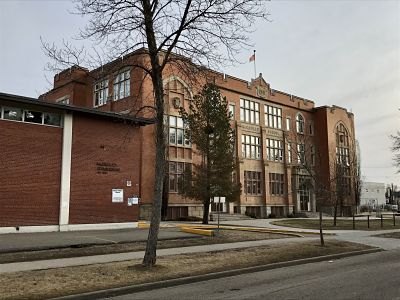
Photo Credit: B. Christy
Fact #43
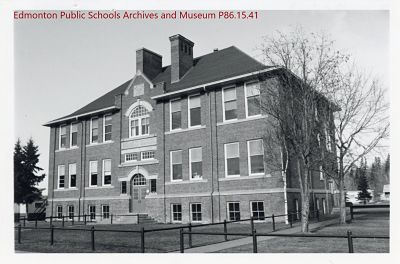
Bennett School: Then and Now
The year 1913 saw an unprecedented opening of 13 new schools in Edmonton. Most of these were temporary buildings designed to meet the needs of a rapidly growing city. Four permanent schools opened that year, construction having started on them in 1912. One of these schools was Bennett School; named after Thomas Bennett, the first mayor of the town of Strathcona and early school trustee. When the North Saskatchewan River flooded in 1915, nearby residents took refuge in the third floor assembly hall of Bennett School. The school was closed in 1973 but reopened in 1981 as the Bennett Environmental Education Centre. Today the Bennett Centre hosts field trips, day retreats, weddings, and overnight group accommodations.
Photo Credit: Edmonton Public Schools Archives and Museum P86.15.41
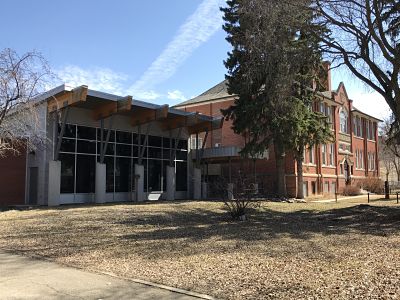
Photo Credit: B. Christy
Fact #44
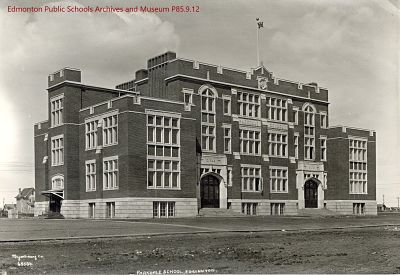
Parkdale School: Then and Now
Parkdale School was scheduled to open on April 13, 1913 however a fire causing more than $20,000 damage delayed the opening by a month. The mythological Phoenix, which rose from the ashes, was chosen as the school’s mascot. Edgar (Spike) Millen, the RCMP officer who was killed in 1932 by Albert Johnson, the Mad Trapper of Rat River, was a student of Parkdale School from 1913-1920. Another notable student was W. P. Kinsella, author of the novel Shoeless Joe that was adapted into the movie Field of Dreams. Parkdale School was closed in June 2010.
Photo Credit: Edmonton Public Schools Archives and Museum P85.9.12
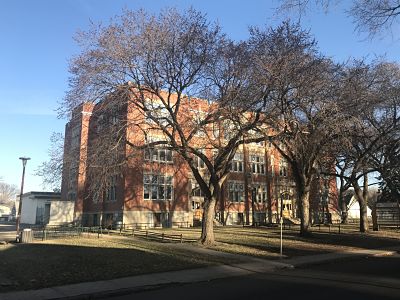
Today, it continues to serve the community as the home of Bent Arrow Traditional Healing Society.
Photo Credit: B.Christy
Fact #45

Donald Ross School: Then and Now
Donald Ross School, which also opened in 1913, was built to accommodate the children of the heavily populated Ross Flats area. Mary McIvor became the first principal and remained so for a record 41 years! The school closed in 1973 with an enrollment of only 44 students. The school was used as the headquarters for the 1978 Commonwealth Games and in 1979 for the City’s 75th Anniversary Celebrations.
Photo Credit: Edmonton Public Schools Archives and Museum P86.15.6
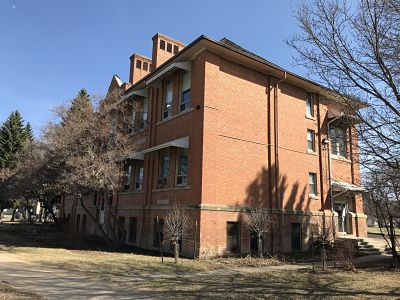
Today Donald Ross School houses Edmonton Public Schools Student Transportation Department, which supports schools by ensuring all students are transported in a safe and timely manner and arrive at school ready to learn. It provides safe, efficient and reliable services for thousands of students who use Division-arranged transportation.
Photo Credit: B.Christy
Fact #46

First Telephones
April 25 was National Telephone Day. In 1908, telephones, similar to this 1907 Long Box Telephone, were installed in five Edmonton Public Schools: College Avenue, Queen’s Avenue, McKay Avenue, Alex Taylor, Norwood and the Board’s office. The phones were all on a party line so all six phones would ring when a call was placed. Each school had a special ring: one ring was for McKay Avenue, two rings for College Avenue... In 1912 the phones were removed because of the continuous ringing and long waits for the telephone to be free for use.
Photo Credit: B Christy
Fact #47
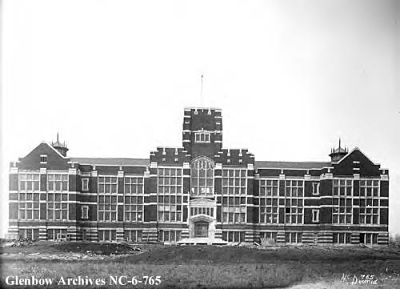
John A. McDougall School: Then & Now
Built in 1913, John A. McDougall School has had a complex history having housed elementary students as well as McDougall Commercial High School. When Kate Chegwin became the first principal of John A. McDougall School she also became the first female principal to head a large permanent school. Shortly after it opened, the commercial classes from Victoria High School moved into the second floor of John A. McDougall and became known as McDougall Commercial High School - home of the famous Commercial Grads basketball team. In 1929 fire destroyed most of the building but it was quickly restored. In 1949 McDougall Commercial High School closed and the classes were transferred to Victoria Composite High School.
Photo Credit: Glenbow Archives NC-6-765
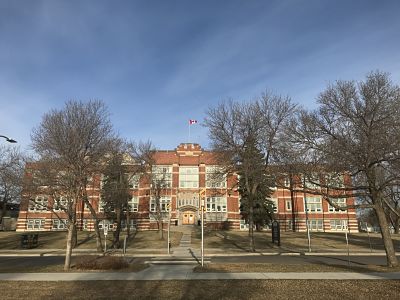
Today, the school is a multicultural hub with the majority of the Pre-Kindergarten to grade six students being English Language Learners. The school works closely with the City Centre Catchment Schools and a variety of community agencies to reduce the impact of socioeconomic circumstances and to maximize the learning opportunities for its students.
Photo Credit: B. Christy
Fact #48
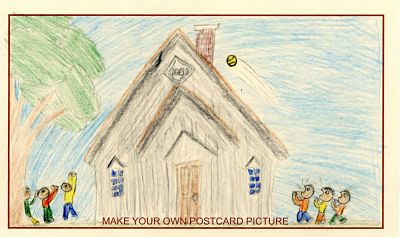
Early Recess Games
Tomorrow, May 1, is National Play Outside Day. Two very popular games played by Edmonton Public Schools students in the past were Anti-Anti-I-Over and Fox & Geese.
Anti-Anti-I-Over, sometimes called Ante Over, dates back to at least the late 1800s. Usually played in the summer it involved two teams, one on either side of the schoolhouse. One team would call out “Anti-Anti-I-Over” and throw a ball over the schoolhouse roof. The other team would attempt to catch the ball. If successful, the whole team would run around the schoolhouse and the person with the ball would attempt to tag members of the other team who would try to run to safety to the other side. If the ball was not caught, the second team would have their turn throwing the ball over the roof.
Source Credit: Archives and Museum Field Trip Postcards
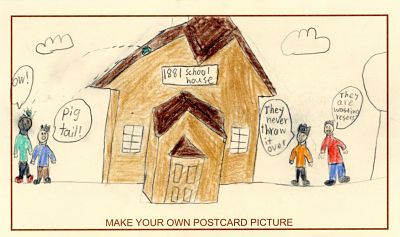
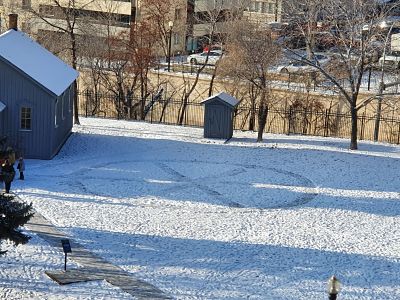
Fox and Geese was a winter game of tag. A large spoked wheel was tramped out in the snow. One person was the fox and the others were geese. All players had to stay on the tramped paths while the fox attempted to tag a goose. If tagged, that person then became the fox. The only safe zone was in the middle where the paths crossed. This was often referred to as the barnyard.
Photo Credit: B. Christy
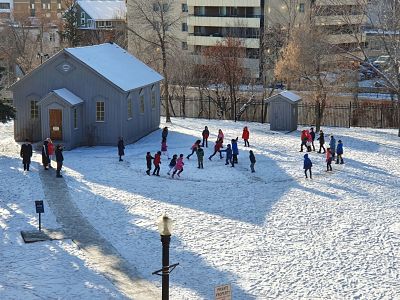
Fact #49

North Edmonton School: Then & Now
North Edmonton School was constructed in 1910 and opened in 1911. It became a part of Edmonton Public Schools in 1913 when the Village of North Edmonton amalgamated with the City of Edmonton. Additions were added in 1923 and 1955 to accommodate growing enrollment. North Edmonton School was closed in 2005 due to low enrollment.
Photo Credit: Glenbow Archives NC-6-771
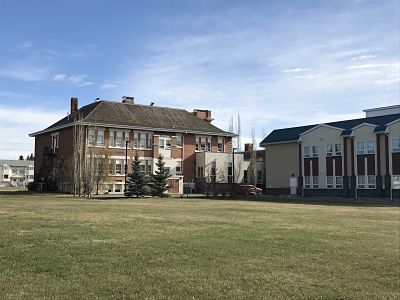
Today the building continues to serve the community as Balwin Villa, an Enhanced Designated Living site designed specifically for clients with brain injury, mental illness or early onset dementia.
Photo Credit: B Christy
Fact #50
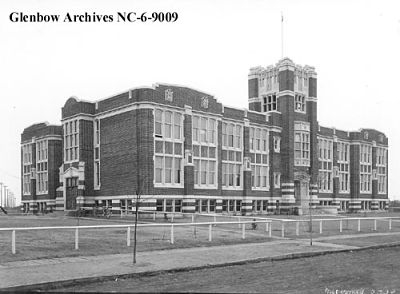
Highlands School: Then & Now
Construction of Highlands School was approved in 1913 but only the first floor had been completed by 1915. It was not until 1920 that most of the second floor was finished and the building was connected to the city’s sewer and electrical service. From 1921 to 1930, Highlands Normal School operated out of the second floor. It was the first teacher training institute in Alberta, serving 110 student teachers in its first year. Six classrooms were added in 1954. For the majority of the last half of the 1900s, Highlands School was a junior high school.
Photo Credit: Glenbow Archives NC-6-9009
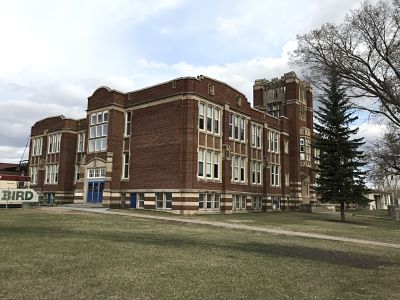
In 2019, a major construction and expansion project began with the demolition of the 1954 addition. A new wing is being constructed and a modernization of the original, historically significant building will take place. In September of 2021, Highlands Junior High will become a Kindergarten to Grade 9 school.
Photo Credit: B. Christy
Fact #51

WWII Honour Roll
Tomorrow, May 8, marks the 76th anniversary of the end of the Second World War in Europe. In 1944, Superintendent of Schools Ross Sheppard reported that 15% of the teaching staff (43 men and 16 women) of Edmonton Public Schools were on a leave of absence serving with the Canadian forces overseas or doing war work in Canada. In 1945, he reported that there was no loss of life due to wartime activities of any staff member. Sadly, of the 1,400 high school students who enlisted, 115 did not return. The sacrifice of these young men and women is still honoured today.
Photo Credit: Edmonton Public Schools Archives and Museum P90.24.52
Fact #52
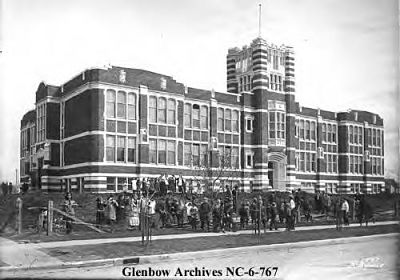
King Edward School: Then and Now
King Edward School opened in 1914. For the first time, the large assembly hall was built on the first floor unlike other schools of the time that had it on the top floor. This allowed for easier use of the hall by the local community. The building had an automatic heat regulator, separate playrooms for boys and girls and “shower baths”. This last feature caused the Edmonton Bulletin to report “This will be a novelty to many of the children who never before saw hot water come down like rain”. In 1920 King Edward School became the city’s fourth experimental junior high school. The experiment was abandoned in 1925. In 1928, six rooms of King Edward School were rented to the government for teacher training, which operated as King Edward Normal School until 1930. Strathcona Commercial School was also located in the building during the 1920s. King Edward School closed in 1984.
Photo Credits: Glenbow Archives NC-6-767
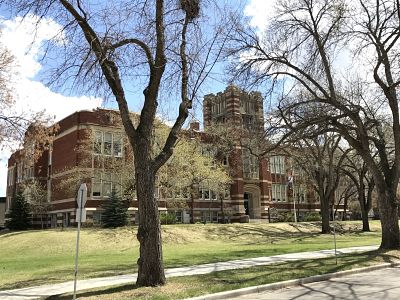
In 1992, it reopened as the Academy at King Edward, which offers specialized programming for students with learning disabilities in Grades 2 to 12. The students are taught, in small classes, to understand their learning strengths and challenges and to develop strategies that allow them to become lifelong learners.
Photo Credit: B. Christy
Fact #53
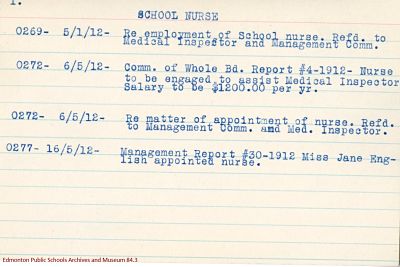
The School Nurse
Today is National School Nurse Day! The School Nurse was a highly sought after position in Edmonton Public Schools, with applications coming from as far as Ontario. The earliest mentions of the School Nurse position in our archive occurred in 1912.
By 1913, when the student population of Edmonton Public Schools had grown to approximately 8000 students, the Medical Inspector was accompanied by two full time School Nurses. The School Nurse salary ranged from $800.00 to $1200.00 per year. At this time, approximately 15 to 20 percent of the student population suffered from “various ailments,” and 30 to 35 percent suffered from “dental defects.”
In 1952, the health services of Edmonton school boards were incorporated into the city health department.
Source Credit: Edmonton Public Schools Archives and Museum 84.3

Fact #54

H. A. Gray School: Then & Now
H. Allen Gray (H. A. Gray) School officially opened in the fall of 1914, although classes had started there in May of that year. Like so many of the schools built at that time, the school was on the edge of the city. Most of the sidewalks in the area were wooden boardwalks and the streets were ungraded trails with the exception of 97 Street which was graded and gravelled.
Photo Credits: Edmonton Public Schools Archives and Museum P85.6.4

The school closed in 1984 and became the Westwood Campus of NAIT. Since 2004, this beautiful building has served the community as the home of Vanguard College which offers various certificate, diploma and degree programs in Christian education.
Photo Credit: B. Christy
Fact #55
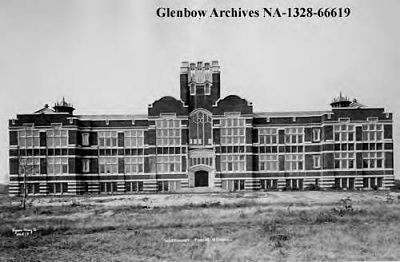
Westmount School: Then & Now
Westmount School is the youngest of our centenarians. Construction began in 1913 but ceased only two months later due to financial difficulties of the Board and a shortage of building supplies. Construction continued intermittently for seven years. The school opened at Easter of 1915 but, like Highlands School, the second floor wasn’t completed until 1920. It became the Division’s first junior high school in 1918. A high school section was opened in 1927 that ran until 1940. In 1936 it became an elementary, junior and senior high school. It reverted to a junior high in 1950.
Photo Credit: Glenbow Archives NA-1328-66619
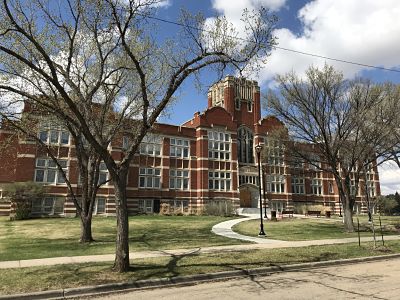
Today, Westmount School continues to support students through regular programming, an Opportunity program to support students living with mild intellectual disabilities and significant academic delays, as well as a sheltered English as a Second Language program to support students learning academic English.
Photo Credit: B. Christy
Fact #56
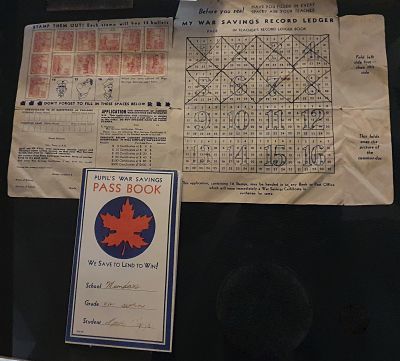
War Saving Stamps
During the Second World War, students in Edmonton Public Schools, and across Canada, participated in many ways to support the war effort. Pass books such as this one recorded a student’s contribution of money for fighting the war. A student could purchase stamps, each worth 25c, and paste them into a pass book. Once the pass book was filled with 16 stamps the student could trade it in for a War Savings Certificate worth $4.00. After five years the certificate could be redeemed at a post-office or bank for $5.00. Loan schemes such as this were used to finance the war.
The sale of War Saving Stamps in schools raised $141,926.40, which is equivalent in purchasing power to over $2,100,000.00 today.
Source Credit: Edmonton Public Schools Archives and Museum 96.29.1; 97.91.1


Fact #57
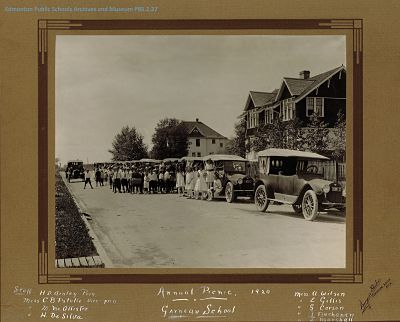
Victoria Day
Victoria Day weekend is here! The observance of the birthday of Queen Victoria dates back to as early as 1845 in Canada, but it was in 1901 that May 24th (Victoria’s actual birthday), or “Victoria Day,” became a national holiday. In 1921, it was re-named “Empire Day.” For many years, on the afternoon preceding May 24th, cadet drills and patriotic exercises in story and song were the order of the day in Edmonton Public Schools. Mass rallies of school children would be organized in school yards or parks to perform Empire Day programs. The aim of these activities was to foster a training and attitude that would produce patriotic citizens of the British Empire. Legislation passed in 1952 established the first Monday preceding May 24th as the Victoria Day celebration.
Photo Credit: Edmonton Public Schools Archives and Museum P85.2.27
Fact #58

Aviation Theme in Edmonton Technical School Night Classes
The Edmonton Technical School was established at a regular meeting of the Board on December 19, 1912. The old street railway car barns on Syndicate Avenue (95 Street) and 108A Avenue were chosen to be remodelled to serve as Tech’s first home. On opening day, October 15, 1913, 12 pupils were registered for instruction; however, by the end of 1914 the enrollment was 322.
Photo Credit: Edmonton Public Schools Archives and Museum P85.5.29
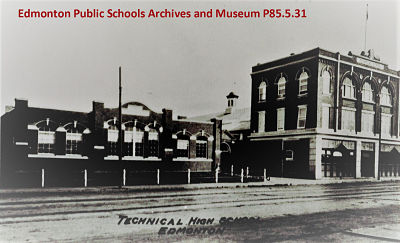
By 1922, a larger building was needed to accommodate the school’s program and on January 3, 1923 classes commenced in the Old Market Building north of 107A Avenue on 101 Street.
During World War II, the school became involved in the war effort. Night classes in aircraft repair, welding, aircraft woodwork, aircraft metal repair work, aircraft machine shop, aero-engines, aircraft electricity and ground-school maintenance were introduced. May 24 was Aviation Maintenance Technician Day and we would like to recognize the contributions of Edmonton’s early Aircraft Technicians to the war effort.
Photo Credit: Edmonton Public Schools Archives and Museum P85.5.31
Fact #59
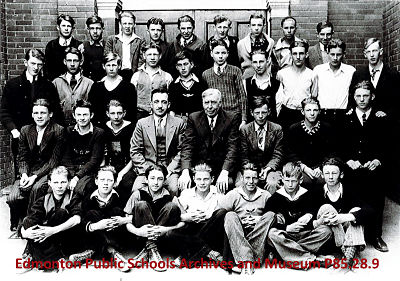
How Building Model Airplanes Supported the Second World War Effort
As part of Edmonton Technical School’s contribution to the Second World War effort, model airplanes were built for the airforce and used for aircraft recognition. A letter from #4 Training Command Headquarters (part of the British Commonwealth Air Training Plan) in Calgary congratulated the students on their models and stated that they were of the very best manufacture. Pictured are students from an Edmonton Technical School woodworking class circa 1935.
Photo Credit: Edmonton Public Schools Archives and Museum P85.28.9
Fact #60

Asian Heritage Month - Bing Mah
Today marks the end of Asian Heritage Month. Throughout the history of Edmonton Public Schools, many well known and lesser known individuals from various cultures have been educated in our schools and gone on to play a valuable role in our city, province and country. One such person is Bing K. Mah who came from China in 1922 at the age of 10. He was a student at Alex Taylor School and was one of the first fully bilingual individuals of Chinese descent in Edmonton.
Throughout his life, Bing Mah worked as a tireless volunteer - as an interpreter for Immigration Canada and Canadian Pacific Airlines, assisting immigrants with visas and passports, organizing fund-raising for the Canadian War Bond program - the list goes on. He was the first Chinese businessman to become a Rotarian in Edmonton where he continued to volunteer his time for 50 years. On May 3, 2004 Bing Mah was included in the list of 100 Edmontonians of the Century.
We appreciate the support of Mr. Mah’s family and the Chinese Benevolent Association for their permission to use his photo on our website.
Photo Credit: Mah Family and the Chinese Benevolent Association
Fact #61
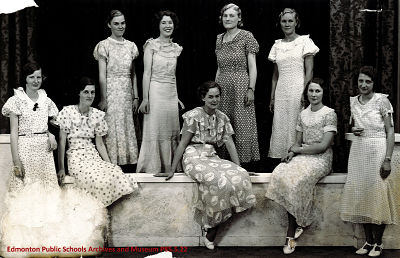
Edmonton Technical School Beginnings
Edmonton Technical School was created for three purposes: to train students who were not likely to finish secondary school and would go to work in various trades; to prepare boys for University courses in a variety of technical fields and girls for University courses in household economics; and to provide evening classes for those who worked during the day.
Night school courses were extremely popular with a wide range of courses being offered. Some academic high school subjects were offered in the evening as well. English for new Canadians was also taught. Tuition fees ranged from $2 to $4 per course depending on the number of times the subject was offered during the 10 week term. Pictured are Tech students modelling dresses designed in night classes.
Photo Credit: Edmonton Public Schools Archives and Museum P85.5.22
Fact #62
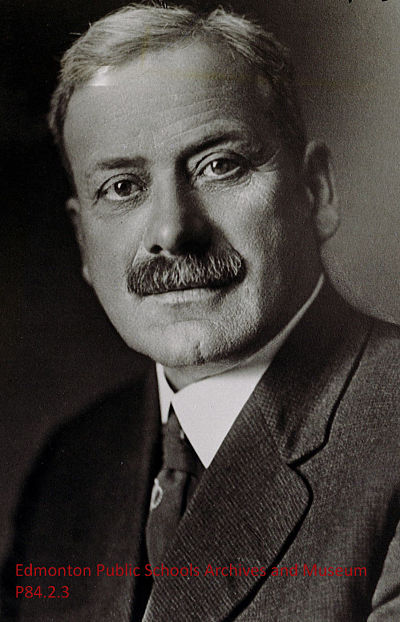
Superintendent James McCaig
In its 140 years, Edmonton Public Schools has had 13 superintendents. The first superintendent was James McCaig who served from July 20, 1906 to October 31, 1913. Ten permanent schools were built during the seven years that he served and five more were nearing completion at the time of his resignation. Superintendent McCaig was a progressive thinker in terms of educational philosophy. He stated that “The ultimate end of school work is character building”. He proposed expanded household science, music, and physical education classes in the belief that a richer curriculum would help keep pupils in school.
Photo Credit: Edmonton Public Schools Archives and Museum P84.2.3
Fact #63
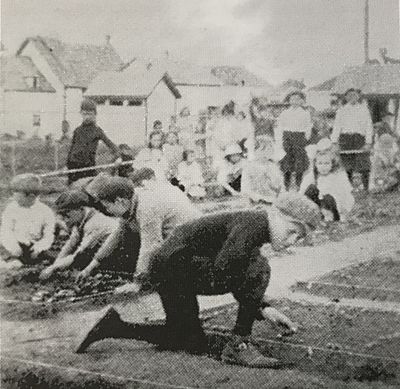
Students Gardening
The first full week of June is National Garden Week. During World War One, the teaching of agriculture and nurturing of school gardens were both educational and patriotic thrusts. Pictured are students in the school garden at Donald Ross School in 1915.
Source Credit: Kostek, M. A., A Century and Ten: The History of Edmonton Public Schools (Edmonton, AB: ASAP Finecolor Printing, 1992), 193.

A newly authorised text book written by former superintendent James McCaig, and special summer school programs for teachers wishing to teach the new course, helped promote interest in the subject. Before the end of the war, most schools had gardens of their own.
Source Credit: McCaig, James, Elementary Agriculture for Alberta Schools (Toronto, ON: W. J. Gage & Co., Limited, 1915)
Fact #64
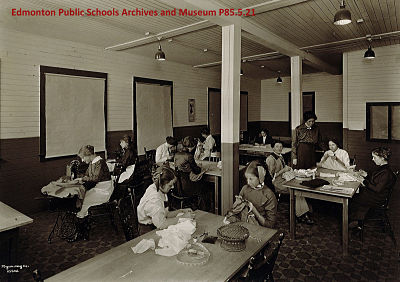
Edmonton Technical School Courses: Part One
Edmonton Technical School offered many courses for girls and women. Pictured are students taking part in sewing and cooking classes as well as a Domestic Science demonstration at the Edmonton Exhibition.
Other evening courses for women included dressmaking, needlework, millinery, nursing science, invalid cooking and dietetics.
Photo Credit:Edmonton Public Schools Archives and Museum P85.5.21

Photo Credit: Edmonton Public Schools Archives and Museum P85.5.23

Photo Credit: Edmonton Public Schools Archives and Museum P85.5.24
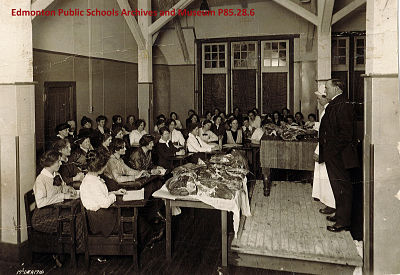
Photo Credit: Edmonton Public Schools Archives and Museum P85.28.6
Fact #65

Superintendent W. G. Carpenter
William G. Carpenter was our second superintendent. He served in this role from 1914 - 1923. At the time of his appointment, Mr. Carpenter was principal of Victoria High School. One of his first tasks as superintendent was to introduce a night school program for new Canadians. Throughout the First World War, Mr. Carpenter kept in close personal contact with most of the staff members who were serving in the military overseas.
Unlike his predecessor, James McCaig who used a horse-drawn rig for transport, Superintendent Carpenter used his automobile, which he purchased in 1919, when making school visits. In 1921, he applied to the Board to cover the cost of new tires, explaining that he had already spent $143.10 on tire repairs and that he used the car almost entirely for work. His request was denied however his travel allowance was increased to $35/month.
Carpenter left his position as Superintendent of Edmonton Public Schools to become principal of the Provincial Institute of Technology and Art in Calgary. He later became Alberta’s Provincial Director of Technical Education.
Photo Credit: Edmonton Public Schools Archives and Museum P85.14.18
Fact #66

Edmonton Technical School Courses: Part Two
Edmonton Technical School offered a wide range of trades courses for boys and young men. There were courses in machine work and tool making, auto mechanics, blacksmithing, printing, mechanical and architectural drafting and sheet metal. Night school courses included many of the day courses as well as coal mining and steam engineering. Pictured are a buttermaking demonstration and the forge and blacksmith shop.
Photo Credit: Edmonton Public Schools Archives and Museum P85.5.1
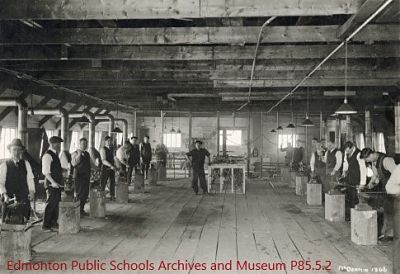
Photo Credit: Edmonton Public Schools Archives and Museum P85.5.2
Fact #67

Edmonton Technical School Closure
Edmonton Technical School saw a drastic decline in enrolment during the first years of the Second World War. In 1943, the Department of National Defence requested the use of the entire school for the Emergency War Training Program. After the war, the school was used for refresher courses for ex-servicemen preparing for university enrollment. In 1947 it was returned to Edmonton Public Schools and used mostly as a warehouse. A few shop classes continued for a short time but these were closed when the new Victoria Composite High School was opened in 1949, absorbing Tech as well as McDougall Commercial students.
Pictured are photos of the demolition of the building in June and July of 1966.
Photo Credits: Edmonton Public Schools Archives and Museum P94.42.40-45
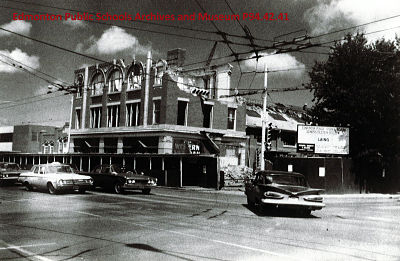
4 Jul 1966

7 Jul 1966

13 Jul 1966
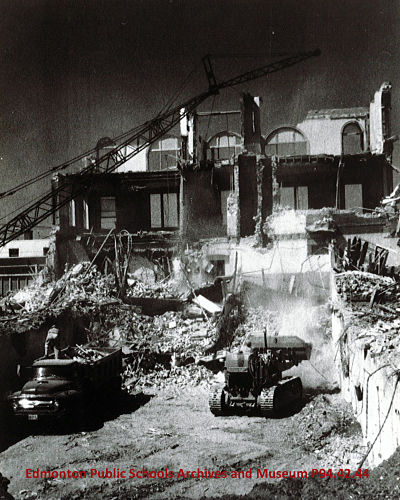
14 Jul 1966

21 Jul 1966
Fact #68

End-of-the-Year Activities: Picnics
The end of the school year always brings with it special activities for the students. This is not something new. Pictured is a portion of a photo taken on June 24, 1922. It shows students and staff from Garneau School celebrating the end of the school year in Victoria Park with their annual picnic.
Photo Credit: Photo By McDermid Studio NOC201 (Annual Garneau School Picnic Victoria Park June 24th 1922)
Fact #69
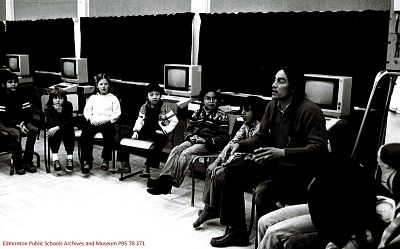
First Nations, Métis, and Inuit (FNMI) Education Programming
Today is National Indigenous Peoples Day in Canada. This day gives us a chance to recognize the many achievements of Canada’s Indigenous peoples and celebrate the distinct cultures and unique traditions of these FNMI communities.
At two Edmonton Public Schools sites, there is a focus on teaching knowledge and honouring of Cree language, values, ancestral knowledge and traditions. At Prince Charles School, children from Kindergarten to Grade 6 are enrolled in the Awasis program (Awasis is Cree for child). This program began in 1973 through the efforts of parents and Edmonton Native rights activist Jenny Shirt Margetts. Awasis became part of Edmonton Public Schools in 1974. Pictured is Mr. T. Alcoze with a class sitting in a circle circa 1990.
In 2000, amiskwaciy Academy opened for students from Grade 7 -12. Most students come from Edmonton and surrounding areas but also First Nations and Metis settlements throughout Western Canada and the Northwest Territories. Although most students are First Nations, Metis or Inuit, students of all cultures are welcome. amiskwaciy is what the Cree people called the area that is now Edmonton. In English it means “Beaver Hills House”. The amiskwaciy Academy’s logo reflects the traditional beliefs of the medicine wheel and is featured in the second photo.
Photo Credit: Edmonton Public Schools Archives and Museum P95.78.371

Source Credit: amiskwaciy Logo
Fact #70

Commercial High Schools
In celebration of National Typewriter Day we bring you the McDougall High School Commercial Class of 1916 posing in front of their typewriters. Their teacher, J. Percy Page, is seated in the front row. Students who intended to pursue a business career could receive instruction and practice in office training at McDougall Commercial High School.
Photo Credit: Glenbow Archives NC-6-2341
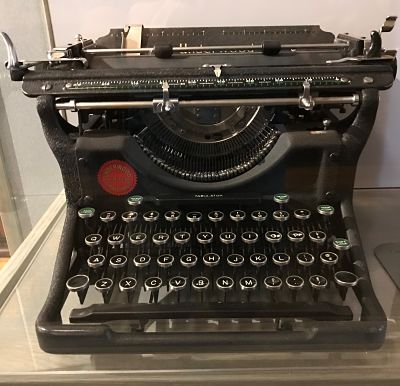
This is a 1926 Underwood Typewriter, similar to the one seen in the class photo.
Photo Credit: B. Christy

This is the oldest typewriter in our museum: The Oliver No. 5 from circa 1908.
Fact #71
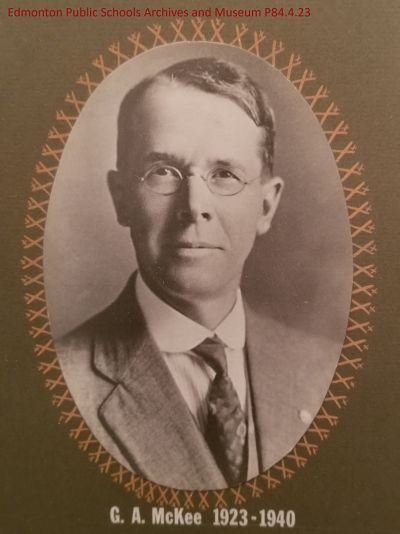
Superintendent George McKee
In 1924, George McKee was appointed as the third Superintendent of Edmonton Public Schools. He remained in this capacity for 17 years until his retirement in 1940. Periods of stability, depression and financial cutbacks were experienced during his tenure.
In his first year as Superintendent, McKee participated in opening ceremonies for three new schools: Garneau, Riverdale and Frank Scott (later renamed Eastwood). He is well remembered for his patience and praiseworthy achievements. Mr McKee was well liked by the teachers and remarkably few teachers resigned or left the Division during his time as Superintendent.
Photo Credit: Edmonton Public Schools Archives and Museum P84.4.23
Fact #72
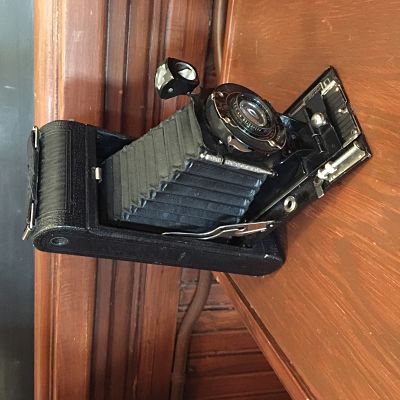
Depression Era Giveaway
Tomorrow is National Camera Day. From May 1 to May 30, 1930, the Eastman Kodak Co. gave away 550,000 cameras to children in the U.S.A. and Canada whose twelfth birthday fell in 1930. The child, accompanied by a parent or guardian, simply went to an authorized Kodak dealer to receive the free camera, a Kodak No. 1A (pictured), plus a free roll of film.
Two stated purposes of this mass giveaway were:
1) In appreciation of the parents and grandparents of these children who had helped amateur photography and Kodak to grow
2) To further promote the popularity of amateur photography
Several Division students were able to receive cameras as part of this campaign.
Photo Credit: B. Christy
Fact #73
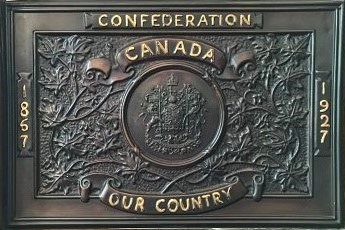
Canada Day
Tomorrow we celebrate Canada Day. Perhaps this is a good day to reflect on the contributions of the people: from the original inhabitants, the Indigenous, all the way to the latest refugees and immigrants, who have helped to create the fabric of this country and what we have to be proud of. It is also a good day to recognize the things that we as Canadians can and should do to make it an even better nation.
The plaque featured in the first picture was presented to most schools in Canada in 1927 to mark 60 years of confederation.
Source Credit: Edmonton Public Schools Archives and Museum 84.59.2

The second and third pictures show a large crowd of spectators watching Edmonton Public Schools students taking part in the Diamond Jubilee celebrations in Victoria Park.
Photo Credit: Edmonton Public Schools Archives and Museum P91.4.2
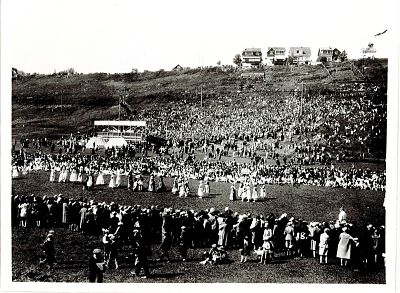
The edge of the river valley in the third picture is certainly much different than today!
Photo Credit: Edmonton Public Schools Archives and Museum P91.4.4
Fact #74
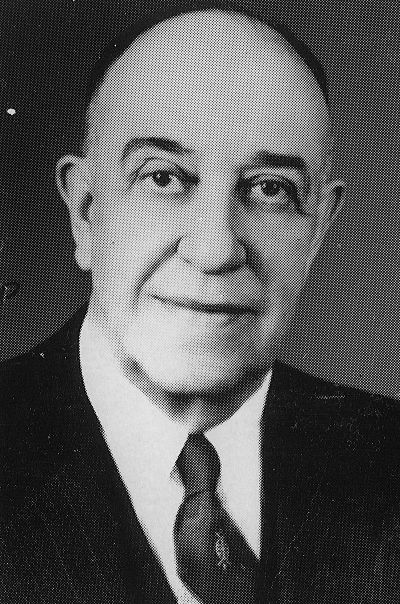
Superintendent Ross Sheppard
From 1940 - 1955, Ross Sheppard served as Edmonton Public Schools fourth Superintendent. During the Sheppard years the number of permanent schools increased from 30 to 63, student enrolment increased by almost 1,000 students per year, and permanent staff doubled. Teacher’s salaries almost doubled from an average annual salary of $2088 in 1940 to $3896 in 1955. Per pupil costs of education increased from $89.19 to $238.25 during the same period.
Ross Sheppard is remembered as a man who tried to maintain close contact with the staff, even to the point of handing out cheques to all the teachers on the last day of June. He graciously thanked each teacher for his or her efforts during the year and took pride in calling each teacher by name, seldom making a mistake in doing so.
Ross Sheppard High School, built in 1957, was named in his honour - a fitting tribute for a man who was a teacher, principal and superintendent for 42 years.
Photo Credit: Edmonton Public Schools Archives and Museum P84.5.27

Mr. Sheppard’s retirement.
Photo Credit: Edmonton Public Schools Archives and Museum P94.65.23
Fact #75

Early Sports Day
Sports Day has long been a highlight of the school year for Edmonton Public Schools students. Today it may go by another name such as Track Day or Fun Day.
Pictured is an outdoor basketball game between the Edmonton High School (later known as Victoria High School) Grade XI and Grade XII girls’ basketball teams during their Sports’ Day at the Exhibition Grounds in October 1911.
Photo Credit: Edmonton Public Schools Archives and Museum P85.4.32

The second picture, taken the same day, is the Grade XI team. The girls are identified as: front row (left to right) Gladys Dunlop, Gladys Cairns, Marion Hodgins and Mary Bell; back row (left to right) Eva McKitrick, Edna Lewis, Eva Bell and Winnifred Heathcote.
Photo Credit: Edmonton Public Schools Archives and Museum P85.4.33
Fact #76
Baseball Through the Years
Over the past 100 years Edmonton Public Schools’ students have taken part in both city and provincial sports championships. We would like to share with you some of the teams from the early 1900s and their accomplishments. We will start off with a look at baseball.

Senior Girls’ Baseball Cup won by the Macks 1924 (McKay Avenue School)
Seated (left to right) Lillian Irwin, Martha Porter, Mr. R. J. Scott, Gretel McCleod, Dorothy Adams; Standing (left to right) Ruth Shandro, Peggy Kirk, Irene Foster, Ruby Irwin, Julia Foster, Nina McGregor, Annie ?
Photo Credit: Edmonton Public Schools Archives and Museum P93.97.1
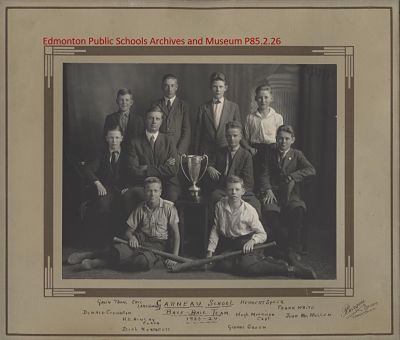
Garneau School Baseball Team 1923-24 Winners of the Preston Smith Baseball Trophy (Senior Boys)
Photo Credit: Edmonton Public Schools Archives and Museum P85.2.26
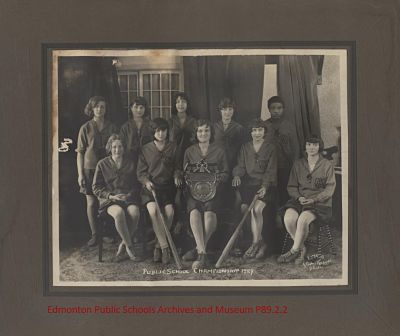
Public School Championship 1929 Queen’s Ave School Baseball Team
Seated (left to right) Helen Moore, Mary Radika, Rose Stupor, Emma Williamson, Lorraine Telford; Standing (left to right) Verlaine Fuller, Mary Stupor, Dorothy Cotton, Winnie Tomlinson, Alva Bradshaw
Photo Credit: Edmonton Public Schools Archives and Museum P89.2.2

Edmonton Public School Baseball Jr. Champs 1934-35 (Eastwood School)
Photo Credit: Glenbow Archives ND-3-7026b
Fact #77

Superintendent W. P. Wagner
From 1955 - 1964, William P. Wagner served as Superintendent of Schools for Edmonton Public Schools. During this time, Edmonton witnessed its largest ever increase in student population (from 43,488 in 1960 to 64,541 in 1965).
Thirty-eight new schools were built during W. P. Wagner’s tenure as Superintendent and the Board moved into its first permanent offices at 107A Avenue and 101 Street. In 1964, all Edmonton Public Schools elementary and junior high schools were teaching the “New Math” program.
A dry sense of humour was a Wagner trademark. He once suggested to Victoria High School Principal, Fred Carr, the father of a very large family, that he should name his last child “Caboose”!
When William Wagner retired, there were approximately 2,000 teachers on staff and this remarkable man could recognise and name most of them.
Photo Credit: Edmonton Public Schools Archives and Museum P92.25.6
Fact #78
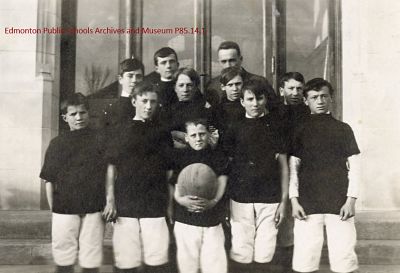
Is it Soccer or Football?
Today’s featured sport is soccer, which in the early 1900s was still often referred to as football.
McCauley School Football Team circa 1912 or 1913
Front row (left to right) ?, Baden Powell, Bobby Douglas (holding ball), Herb Robinson, ?; Middle row (left to right) ?, Scotty Thompson, ?, _ Schoepp; Back row (left to right) Bill Stanley, Mr. McKnight
Photo Credit: Edmonton Public Schools Archives and Museum P85.15.1
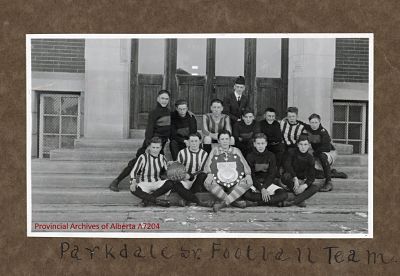
Parkdale Sr. Football Team 1922
Winners of the S. A. G. Barnes Trophy (Edmonton Public School Football Championship Shield)
Photo credit: Provincial Archives of Alberta A7204
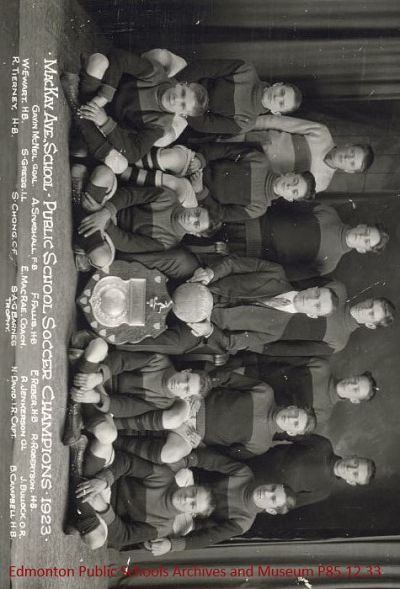
MacKay [sic] Ave. School - Public School Soccer Champions 1923
Winners of the S. A. G. Barnes Trophy (Edmonton Public School Football Championship Shield)
Photo Credit: Edmonton Public Schools Archives and Museum P85.12.33
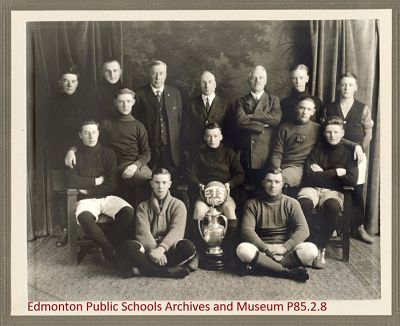
Edmonton Technical School Football Team 1925
Winners of the 1925 Rutherford Inter-Collegiate Challenge Cup
The cup was donated by the Honourable A. C. Rutherford for Association Football Competition in the High Schools of Central Alberta.
Photo Credit: Edmonton Public Schools Archives and Museum P85.2.8
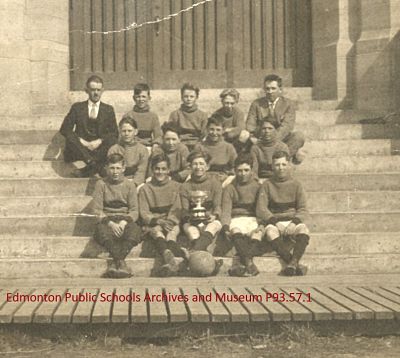
Eastwood School Soccer Champions 1926
“Eastwood Juniors Beat Ross Flats Public School Championship at Stake When Teams Met on Wednesday”
In a strenuous game played on the large field at Renfrew park, Eastwood Juniors defeated Ross Flat Juniors by a score of 2-0 on Wednesday and thereby annexed the championship of the city. Every member [played] exceptionally fine, aggressive game. The winners were worth the win and had a large percent of territorial play.
The goals were scored by John Hrynuk and Charlie Williams. The two full backs, Tom Visser and Gordon McGillivrary, played a fine defensive game. The game was refereed by Mr. Ainsley of Garneau School.
The winners lined up: goal, Albert Whelpley; backs, Tom Visser, Gordon McGillivray; halves, John Woods, Leonard Hope, Harry Robertson; centre, John Hrynuk (captain); forwards, Charlie Williams, Jack Stevens, Frank Linklater and Albert Darkes.
Photo Credits: Edmonton Public Schools Archives and Museum P93.57.1
Fact #79

Rugby
We’ll continue our feature of sports teams with a short post picturing the Strathcona High School Rugby Team. They were winners of the 1926 Provincial Championship.
Photo Credit: Edmonton Public Schools Archives and Museum P88.1.23
Fact #80
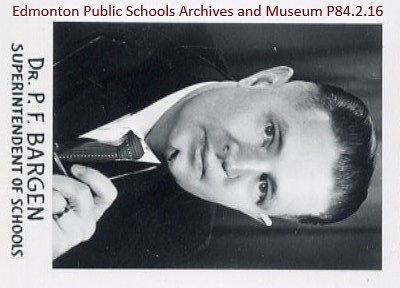
Superintendent Dr. Peter Bargen
Our sixth superintendent was Dr. Peter Bargen; he was our first superintendent to hold a Ph.D. Although his tenure was brief (1964 to 1967), a great deal happened during those three years: the town of Jasper Place amalgamated with the City of Edmonton, Teacher Aides (Educational Assistants) were introduced into elementary schools in 1966, summer school driver education courses were introduced, schools experimented with television and expanded special education programs. Dr. Bargen resigned his position in 1967 to accept a five-year contract as the Chief Commissioner of the City of Edmonton.
Photo Credit: Edmonton Public Schools Archives and Museum P84.2.1
Fact #81
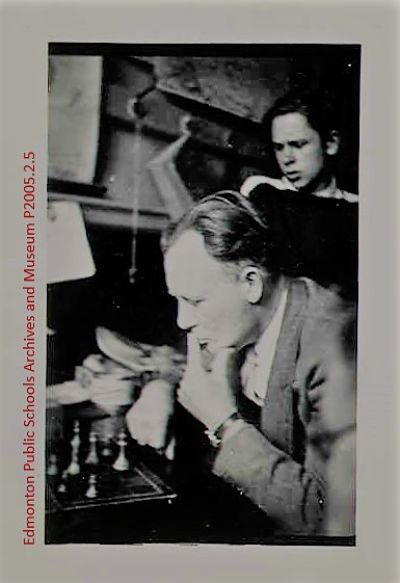
Chess Club
Chess clubs have been a feature of Edmonton Public Schools elementary, junior and senior high schools for many years. Today’s picture (circa 1945-46) shows a man playing chess. He appears to be in a classroom with a student standing behind him. The donor of the photo identified the man as Walter Stewart. Teacher allocation lists indicate that Walter R. Stewart was employed by EPSB from 1929 - 1971.
Photo Credit: Edmonton Public Schools Archives and Museum P2005.2.5
Fact #82
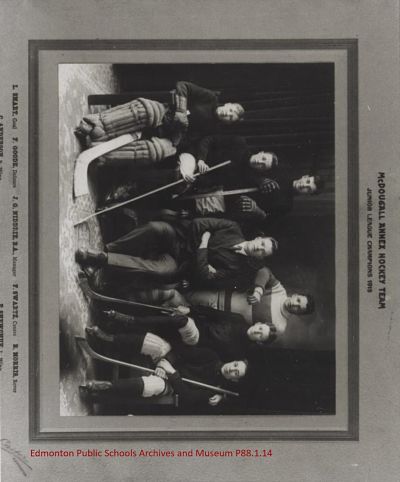
Canada’s Sport: Hockey
No look at school sports in Canada would be complete without including hockey!
McDougall Annex Hockey Team: Junior League Champions, 1918
Photo Credit: Edmonton Public Schools Archives and Museum P88.1.14
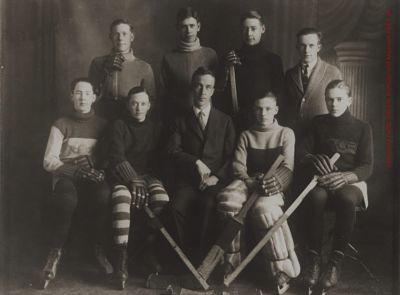
Strathcona High School Hockey Team: Junior League Champions, 1924
Photo Credit: Edmonton Public Schools Archives and Museum P88.1.24

Bennett Hustlers Hockey Team, 1932
The Hustlers defeated the South Side Wolverines 2-1 in the third game of their playoff series to win the 1932 Northern Alberta Junior Girls’ Hockey Championship. The Wolverines had not lost a single game in the regular season.
Photo Credit: Edmonton Public Schools Archives and Museum P88.4.6
Fact #83
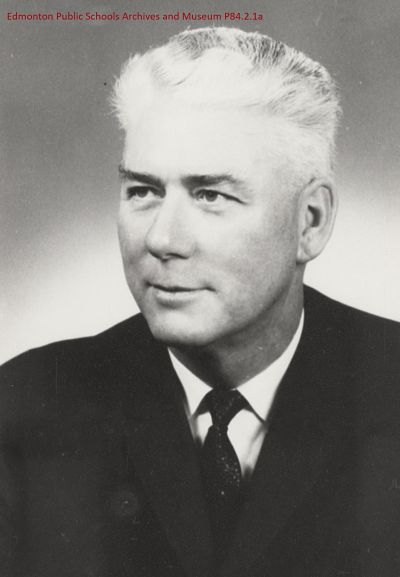
Acting Superintendent T. D. Baker
Following Dr. Peter Bargen’s departure, T. D. Baker served as Acting Superintendent from July 1 to November 14, 1967. Previously, during his role as Deputy Superintendent, Tom Baker made his most significant contributions to the Division. He played a vital role in the 1956 reorganization of central staff. The greatest challenge facing him during this reorganization was the provision of special education services. The name T. D. Baker would become synonymous with the special education programs offered by Edmonton Public Schools. The Glenrose School Hospital, W. P. Wagner Vocational School and L. Y. Cairns School were, in large measure, conceived by Deputy Superintendent Baker.
Photo Credit: Edmonton Public Schools Archives and Museum P84.2.1a
Fact #84
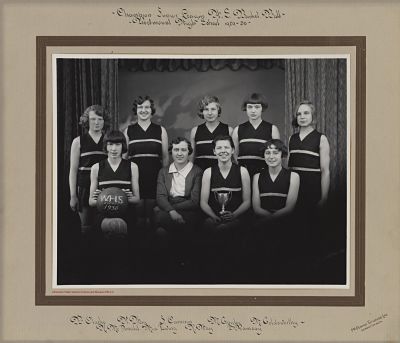
Basketball
Basketball will be the last sport featured in our look at school sports. Pictured are the 1929-30 Westmount High School Junior Girls’ Basketball Team after winning the junior league championship. The individuals are identified as: back row (left to right) B. Clarke, K. Hay, J. Cameron, M. Gayler, M. Goldsworthy; front row (left to right) N. McDonald, Miss Ewing(coach), N. Hay, E. Ramsay.
Photo Credit: Edmonton Public Schools Archives and Museum P85.2.9
Fact #85

The Edmonton Commercial Grads
It would be far too lengthy to give a complete history of “the Grads” in one post. Originally formed at McDougall Commercial High School and coached by teacher J. Percy Page, the team won the 1914 city championships and the next year won the provincial final. As the high school had no gym, the girls practiced twice weekly on an outdoor court year-round.
Upon graduation in mid-1915, the girls decided they wanted to continue playing basketball and established what became the Commercial Graduates Basketball Club. The team was called the Commercial Graduates or informally “the Grads” and J. Percy Page continued as their coach.
The team won its first national championship in 1922 and held it until 1940. For 17 years the Grads held the Underwood Trophy, symbolic of international basketball supremacy. Basketball was not yet recognised as an Olympic sport, however, the Grads were invited to exhibition contests at the 1924, 1928, 1932 and 1936 Olympics. They played a total of 51 games at the Olympics as well as in European exhibitions and won all of them. No wonder Dr. James Naismith, the Canadian who invented basketball, described the Grads as the greatest basketball team in the world.
Photo Credit: Glenbow Archives NA-3521-3
Fact #86
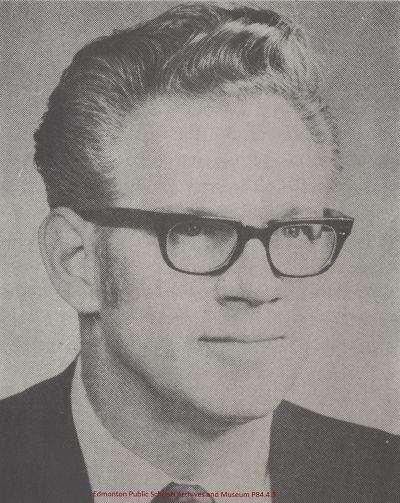
Superintendent Dr. Rolland Jones “Doc J.”
Our seventh superintendent, Dr. Rolland Jones, came from the United States. During his tenure (1967 - 1972), there were many innovations in curriculum as well as the updating of school libraries and resource centers. Inservicing and professional development for teachers played a role never before seen in schools. Under his leadership, Edmonton Public Schools became more of a K-12 organization rather than a separate elementary, junior and senior high school system.
Superintendent Jones often pursued his responsibilities with an air of informality, hence the moniker “Doc J.” Also, during a student sit-in at the Board offices in 1970, Dr. Jones dismissed suggestions of calling in the police, choosing instead to sit down amongst the protestors. After an hour of quiet conversation with the students they left peacefully with the promise that their views would be communicated to the trustees immediately.
Jones submitted his letter of resignation on August 22, 1972, indicating that he had accepted the position of Superintendent for Charlotte and Mecklenberg County schools in North Carolina.
Photo Credit: Edmonton Public Schools Archives and Museum P84.4.3
Fact #87

Division Administration Offices: Mortlake Block (1909-1915)
In 1906, Superintendent James McCaig became the first full-time official of Edmonton Public Schools and a room was rented in the Edmonton Bulletin building to serve as his office. For the 24 years prior to this, the part-time Secretary-Treasurer carried out his duties from his private business office and the Board met in various places - sometimes in the office of the secretary-treasurer, or in the schoolhouse - even in the homes or private offices of the Trustees. In 1907, they moved across the street to three rooms in the Archibald Block and then in 1909 to an entire floor of the Mortlake Block (pictured).
Photo Credit: Glenbow Archives NC-6-691
Fact #88
.jpg)
Superintendent Michael Strembitsky
Michael Strembitsky began his career with Edmonton Public Schools in 1956 as a teacher at Crestwood School. On January 23, 1973 he was appointed as the eighth Superintendent of Schools. He is probably best known for implementing school-based budgeting and management which allowed individual schools to make their own decisions on what was needed, based on the budget provided. Edmonton Public Schools was the first large school division in North America to adopt this approach. He also changed the system of closed boundaries to open boundaries allowing parents true school choice and introduced a range of alternative and second language programs. The system that Dr. Strembitsky introduced has been copied around the world. Time Magazine, in its October 13, 2003 issue, referred to Edmonton Public Schools as “the most imitated and admired school system in North America.''
In May of 1994, Mr. Strembitsky resigned to take a position with a Washington, D.C. “think tank” promoting reform and restructuring of school districts in the United States.
In August of 2016, the Edmonton Journal reported that Mr. Strembitsky, at the age of 81, had been hired by Nevada’s Clark County School District to oversee the overhaul of their district.
Photo Credit: Edmonton Public Schools Archives and Museum
Fact #89
.jpg)
Division Administration Offices: Civic Block (1915-1947)
In 1915, the Division offices moved from the Mortlake Block to the fifth floor of the Civic Block (pictured), where space was rented for $250 per month. This location was used until 1947 when the rapid growth of the city, following the discovery of oil in the Leduc area, made it necessary to find larger quarters. After some investigation, the various departments of the administration were divided and housed in Victoria School, McKay Avenue School, and the old Technical School buildings until the mid 1950s.
Photo Credit: City of Edmonton Archives EA-0-2
Fact #90
.jpg)
Division Administration Offices: Administration Building (1956-1984)
In 1956, construction began on the first permanent office space for the Division (portion of building left of car in the photograph). The site of the new Administration Building was on 101 Street and a half block north of 107A Avenue (which was previously occupied by the old Technical School). The new building would support the new central organizational structure.
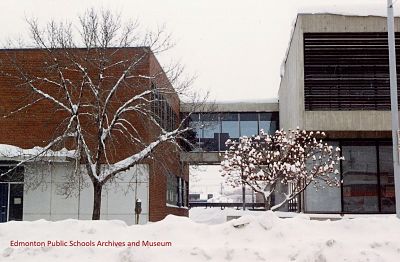
In 1967, a large addition was completed (right of car in first picture), connected by a pedway to the 1956 structure.
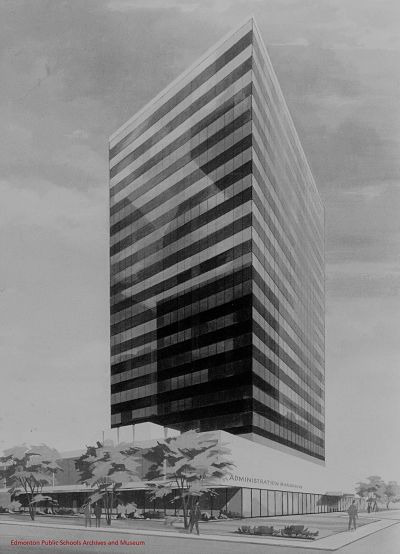
According to the architect’s rendition this addition was to include a sixteen-storey office tower to meet the future needs of Edmonton Public Schools. This tower was never seriously considered as it would have interfered with air approaches to the municipal airport.

Photo Credits: Edmonton Public Schools Archives and Museum
Fact #91
.jpg)
Left-Hand Desks & Instruction
Up until the 1950s, writing with one’s left hand was frowned upon and in many classrooms forbidden. By the 1950s this attitude was changing. Manuals on providing writing instruction to left-handed students were made available and in early 1950, Edmonton Public Schools purchased 100 left-handed desks in an experiment to aid left-handed students. These desks more than proved their value in aiding to the posture and penmanship of the students who used them. The purchase of an additional 350 left-handed desks was approved in July of 1950.
Source Credit: Edmonton Public Schools Archives and Museum 86.138.79
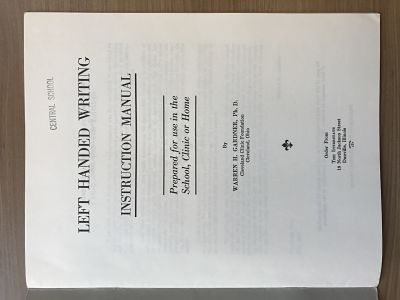
.jpg)
Photo Credit: B. Christy
Fact #92
.jpg)
Division Administration Offices: Centre for Education (1984 to present day)
By 1980, the Administration Building was not meeting the needs for the Division’s offices. Plans for a new and larger administration building were announced in 1980 after it was decided that the costs were not practical to renovate and upgrade the existing offices. On September 28, 1984, the Centre for Education, or “Blue Building'' as it has been nicknamed, was opened. Thanks to the vision of then Superintendent Michael Strembitsky, who was involved in the planning of the building, it continues to meet the needs of Edmonton Public Schools.
Photo Credit: Edmonton Public Schools Archives and Museum
Fact #93
.jpg)
Oldest Known Photograph
This picture, taken in 1886, is the oldest known photograph of an Edmonton Public School. It shows the teacher, Mr. W. H. Carson with his class of 51 students. Students were a wide variety of ages and older students would help teach the younger students. You can use the second picture and the list below to identify almost all of the students. We’re sure you will recognize many of the surnames!
Photo Credit: Provincial Archives of Alberta B3894
.jpg)
(1)Mr. Carson (2)Johnnie Roland (3)Gus Fulton (4)Seton Anderson (5)Archie Rowland (6)Fred Hudson (7)Percy Henderson (8)Peck Rowland (9)Fred Robertson (10)May Henderson (11)Annie Fulton (12)Lizzie McKernan (13)Mamie Ross (14)Robena Henderson (15)Clare Norris (16)Nettie Henderson (17)Victoria Garneau (18)Alice Irwin (19)Arclos Garneau (20)?? (21)Howard Cameron (22)Kate MacDonald (23)Alex McCauley (24)Emma Rowland (25)Maggie Young (26)Charlotte Rowland (27)Maria Fraser (28)Jennie Goodridge (29)Maggie Hardisty (30)Betsy Rowland (31)Issie Henderson (32)Jimmie Fraser (33)Maggie McCauley (34)Tommie Henderson (35)Eddie Fulton (36)Mary LeRoe (37)Lillie McCauley (38)Eliza MacDonald (39)Archie Rowland (40)Chas. Henderson (41)Willie Groat (42)?? (43)Sammie Rowland (44)Jimmie Ross (45)Lew LeRoe (46)?? (47)Geo. Groat (48)Outram Anderson (49)?? (50)Johnnie Cameron (51)?? (52)? Garneau
Fact #94
.jpg)
Superintendent Emery Dosdall
Emery Dosdall became our ninth Superintendent of Schools on January 1, 1995. He came to this position at a time of great economic difficulty. Division funding had been cut by the provincial government by 12.4% and school boards had lost their authority to assess local property taxes. Full funding for charter schools had also been established by the provincial government. Mr. Dosdall successfully met this challenge by greatly expanding alternative programming choices throughout Edmonton Public Schools. He retired from Edmonton Public Schools in 2001 to become Deputy Minister of Education for British Columbia.
Photo Credit: Edmonton Public Schools Archives and Museum
Fact #95
.jpg)
School Supplies: The Slate
Back to school means studying lengthy school supply lists and making purchases. This aspect of life was perhaps much simpler when our first school opened in 1882. An item in the Edmonton Bulletin of Saturday, December 31, 1881, reminding parents of the opening of the school, contained the following sentence: “Books, slates, etc., should be got in readiness beforehand.”
Slates were used in Edmonton Public Schools until the early 1900s. Students were not permitted to use paper until their fourth year as paper was very expensive and in short supply.
Photo Credit: B. Christy
Fact #96
.jpg)
School Supplies: The Early Years
In the early years, Edmonton Public Schools provided students with school supplies. This included exercise books, pen holders and nibs, ink, ink blotters, pencils and mucilage (glue). Pictured are some of the supplies students would have received. The High School Exercise Book in the second photo belonged to a student at Strathcona High School. It came from E. N. Kennedy Co. School Books & Supplies, Edmonton, Alta. In March 1921, the Board passed a resolution that school supplies, with the exception of “exam. cap., ink, pen points, pen holders, chalk and blackboard erasers,” would be furnished to grades one and two only.
.jpg)
Photo Credits: B. Christy
Fact #97
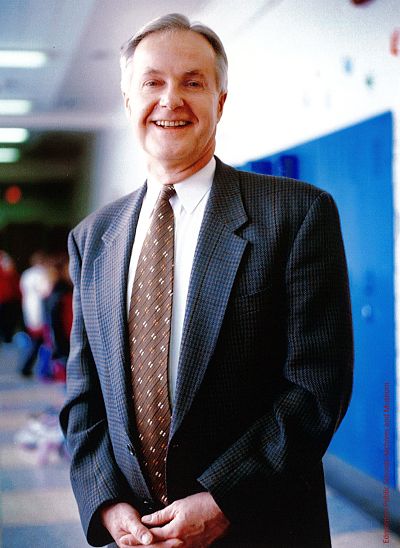
Superintendent Angus McBeath
Having served as Acting Superintendent from May 1, 1994 to December 31, 1994, Angus McBeath became the tenth Superintendent of Edmonton Public Schools in 2001. He was the seventh Superintendent to have risen through the ranks of our school system, having started in 1976. His focus as Superintendent was on improving student achievement as well as teacher and principal performance and accountability. He retired on October 31, 2005 but continued to serve public education through speaking and consultant roles.
Photo Credit: Edmonton Public Schools Archives and Museum
Fact #98
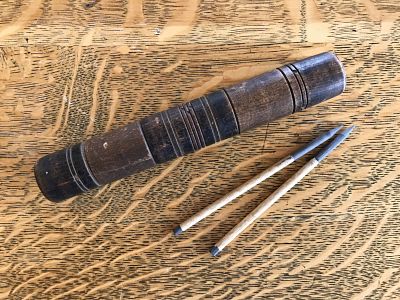
School Supplies: The Pencil Box
Students of today would have a difficult time fitting all their markers, pens, etc. into a pencil box used by an Edmonton Public Schools student in the past. Pictured are a variety of pencil boxes used by students even as recently as the 1960s.
This case is over 100 years old. The cylindrical container was designed to hold the slate pencils, which were quite fragile and needed to be handled with care.

A common pencil box had two decks. The lid would slide back and the top deck would swing out to allow access to the bottom deck. Many were decorated with a nursery rhyme or scene.
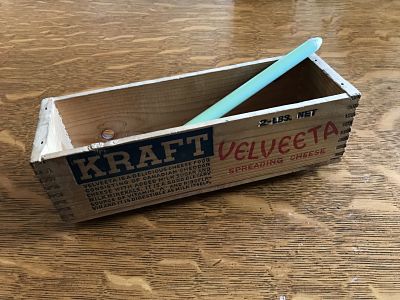
A budget-friendly, simple solution was a small Kraft cheese box.
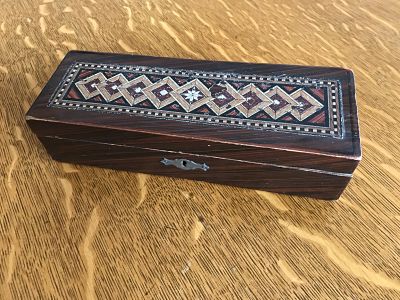
A more elaborate option was a “Wood-inlay” box like this one. Manufactured in Brazil, it is inlaid with seven different types of wood.
Photo Credits: B. Christy
Fact #99

Inauguration Day 1905
On September 1, 1905 the Province of Alberta was inaugurated in a ceremony that took place at the Exhibition Grounds. At that time, they were located in Rossdale. Pictured are students from McKay Avenue School taking part in the children’s parade that was part of the day’s events. McKay Avenue School is the tallest building seen on the edge of the river valley.
Photo Credit: City of Edmonton Archives EA-10-798
Fact #100

Superintendent Edgar Schmidt
Edgar Schmidt became the eleventh Superintendent of Schools after Lyall Thomson’s short term as the tenth Superintendent (January 11, 2007 - April 30, 2007). Mr. Schmidt previously held the position of Acting Superintendent from November 1, 2005 - January 10, 2007. Like others before him, he started his teaching career with Edmonton Public Schools. His focus during his time as Superintendent of Schools was on improving high school completion rates. Mr. Schmidt retired from Edmonton Public Schools on August 11, 2013. He is presently Dean of Education at Concordia University.
Photo Credit: Edmonton Public Schools Archives and Museum
Fact #101
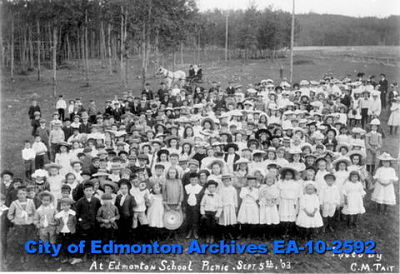
The School Picnic
It would appear that a school picnic was a “beginning of school” activity at one time. This photo entitled “At Edmonton School Picnic, Sept. 5th,’03” was taken by C.M. Tait. It is a fine example of children’s clothing at the time.
Photo Credit: City of Edmonton Archives EA-10-2592
Fact #102
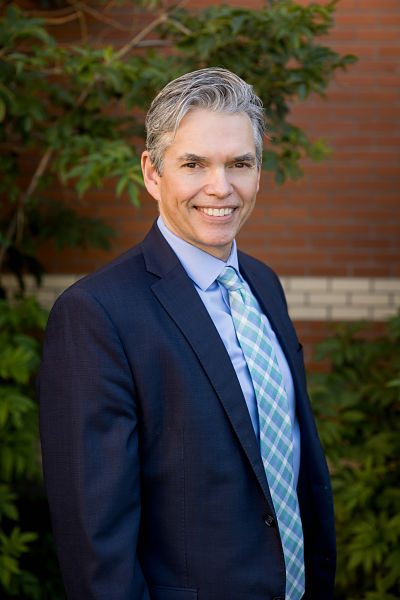
Superintendent Darrel Robertson
Darrel Robertson became the 13th Superintendent of Edmonton Public Schools on August 12, 2013 and continues to serve in that role. Some of his accomplishments to date include the establishment of an equity fund to help schools respond to the unique needs and challenges some students face as well as Career Pathways, an initiative that allows students from Kindergarten to Grade 12 to develop skills needed for the future. On July 7 of this year, Darrel Robertson was named Canadian Superintendent of the Year by the Canadian Association of School System Administrators.
Photo Credit: Rina Chan, Infused Studios
Fact #103
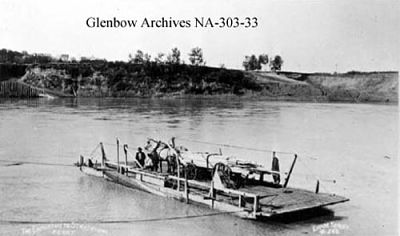
Getting to School
Today, many Edmonton Public Schools’ students arrive at school on a yellow school bus. In the early days, walking was the major “form of transportation” for students. As there was no school on the south side of the river until 1892, students of what was then called the Village of South Edmonton had to cross the North Saskatchewan River in order to attend the Edmonton School. In the summer they would use John Walter’s ferry. In the winter they would walk across the frozen river. In early autumn and late spring, when the ferry was nonoperational and the ice was unsafe to walk on, students of the south side would have a “vacation”.
On September 9, 1952 a delegation from the Buena Vista district appeared at the Board meeting to request that the Board provide transportation for children of the area as they had to travel three miles to Garneau School. The newspaper the following day reported that one Trustee pointed out that Edmonton Public School Board had never made a practice of providing transportation and that similar requests had been refused in the past. The Buena Vista request was also denied. The delegation from Buena Vista worked with City Commissioners and at the October 7, 1952 Board meeting, bus service to Jasper Place and Glenora School for children residing in Buena Vista was approved. The Department of Education would provide a grant of $6 per day to be paid to the Edmonton Transit System as their cost for the operation of the bus service.
Photo Credit: Glenbow Archives NA-303-33
Fact #104
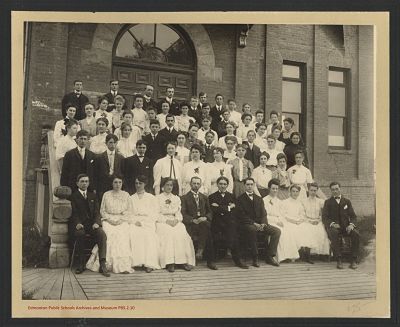
Organizing Students
In Fact #26, we reported that College Avenue School was used exclusively for high school classes from 1903 - 1911. Prior to this, it had been used to accommodate younger students as well.
At this time, students were organized by Standards and spent two years in each Standard (except Standards 5, 7 and 8 which were each a year). There were five Standards at the public school level and three at the high school level.
By 1912, organization by Grade levels replaced the Standards. Standard 1 became Grades 1 & 2; Standard 2 became Grades 3 & 4; Standard 3 became Grades 4 & 5; Standard 4 became Grades 6 & 7; Standard 5 became Grade 8; Standard 6 became Grades 9 & 10; Standard 7 became Grade 11; Standard 8 became Grade 12.
As a side note, Grades 1-8 were called “public school” and Grades 9-12 were called “high school”. It was in 1936 that the 6-3-3 organization was implemented and the terms elementary, junior and senior high school were used.
Photo Credit: Edmonton Public Schools Archives and Museum P85.2.10
Fact #105
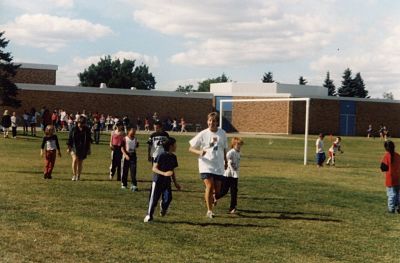
The Terry Fox Run
This year is the 40th Anniversary of the Terry Fox Run. The first run was held on September 13, 1981. The following year, schools were invited to participate with their own events. Students of Edmonton Public Schools have been participating in this run since its inception. Pictured are students from Princeton School participating in their Terry Fox Run in 1999.
Photo Credit: Edmonton Public Schools Archives and Museum
Fact #106
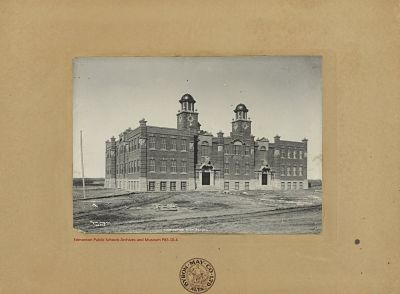
Edmonton High School
The first school built exclusively for high school students in Edmonton opened on May 11, 1911. Edmonton High School had twelve classrooms, a science laboratory, library, main floor auditorium and sub-basement gymnasium. In addition to regular academic subjects, students could choose from art, physical culture, manual training, domestic science and some commercial courses. The name of the school was changed to Victoria High School in 1913. In our next three posts, we will follow the journey of Victoria High School to what is known today as Victoria School of the Arts.
Photo Credit: Edmonton Public Schools Archives and Museum P85.10.4
Fact #107
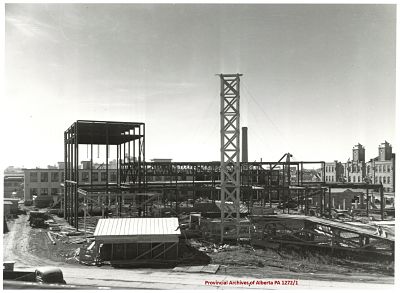
The Composite High School
In the mid 1930s, students could still choose to attend a specific type of high school (regular, commercial or technical) according to their aspirations, aptitudes and interests. Major changes to the curriculum led to the provincial move to organize composite high schools. These would offer a diverse high school program to all students, within a single setting.
A composite high school became firmly entrenched in Edmonton Public Schools when the first unit of the new Victoria Composite High School officially opened in 1949. Although planned in the late 1930s, construction had been held up due to the shortage of structural steel.
Photo Credit: Provincial Archives of Alberta PA 1272/1
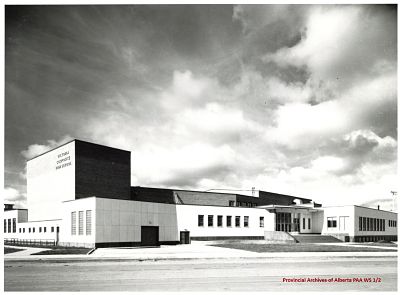
Photo Credit: Provincial Archives of Alberta PAA WS1/2
Fact #108
.jpg)
Victoria Vocational High School
On April 19, 1962, the students of the “red building” (the original 1910 building) were informed that the old school was being demolished to make way for a vocational school. The federal government would provide up to 75% of the cost of the new facilities and equipment should the building be completed by March 31, 1963. Victoria Vocational High School was completed on time and opened in September 1963. Although it initially operated separately, in 1965 the Board amalgamated the two units as Victoria Composite High School.
David Murray described the 1963 addition as a Structural Expressionist Style of architecture, with the use of decorative mosaic spandrel panels, as well as the expressed structural grid and continuous sunshades. These details are clearly evident in today’s photograph.
Photo Credit: B. Christy
Fact #109

Victoria School of the Arts
In the late ‘60s and early ‘70s the student population of Vic Comp fell dramatically and subsequently courses were dropped, particularly in modern languages, music and performing and visual arts. Again, Vic opened her doors to new types of students. Some were adults who came as day students to the Continuing Education Centre, formerly the east academic wing of the composite high school. Trades and Services students, who needed special types of education, also enrolled at the school.
In the late 1980s Victoria Composite High School, under the direction of Principal Bob Maskell, was transformed into a school focusing on the performing and fine arts. It was renamed Victoria School of Performing and Visual Arts and operated as a kindergarten to grade 12 arts-based alternative school.
In 2011, following the completion of a major modernization, the name of the school was changed to Victoria School of the Arts. It is regarded as one of the top arts based schools in North America.
Photo Credit: B. Christy
Fact #110
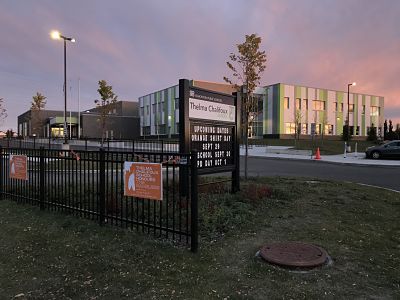
Schools with Indigenous Names
Throughout history, Indigenous peoples have played significant roles in shaping this country. When Mee-Yah-Noh school opened in 1961, for the first time Edmonton Public Schools used a term from the Cree language to name a school. Since then, the names of several schools have used Cree words or expressions. More importantly, in the past five years, three new schools have been named after Indigenous women in recognition of their valuable contributions to Indigenous people and Canada. The most recent of these is Thelma Chalifoux School which opened in September 2020.
Here is a list of all Division schools with Indigenous names, the year they opened and the English translation:
Mee-Yah-Noh (1961) - "fair view"
Ekota (1976) - "special place"
Satoo (1976) - "jumping" also name of early Cree Chief
Kameyosek (1977) - "the beautiful place"
Steinhauer (1977) - Henry Bird Steinhauer, who was Ojibwa originally from Rama First Nation
Sweetgrass (1979) - Cree Chief
Meyonohk (1980) - "an ideal place to be"
Sakaw (1980) - "wooded area"
Keheewin (1981) - "Kehee" meaning "eagle"
Menisa (1981) - "many berries"
Meyokumin (1981) - "sweet water"
Tipaskan (1983) - "reserve"
amiskwaciy Academy (2001) - "Beaver Hills"
Nellie Carlson (2016) - long-time activist for Indigenous Women
Shauna May Seneca (2017) - co-founder of Bent Arrow Traditional Healing Society
Thelma Chalifoux (2020) - Canada’s first Metis Senator
Photo Credit: B. Christy
Fact #111
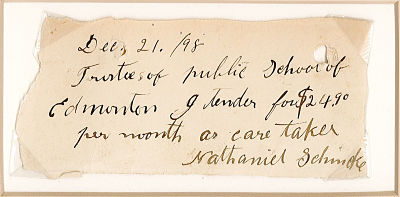
Custodial Appreciation Day
Every October we acknowledge Custodial Appreciation Day. Pictured is a tender submitted for a custodial position with Edmonton Public Schools in 1898.
Source Credit: Edmonton Public Schools Archives and Museum 84.9
We would like to give a well deserved “thank you” to all the custodians of Edmonton Public Schools who work so hard to keep our schools clean and safe for our students and staff.
When the third classroom was added to the original schoolhouse in 1891, the Board showed their appreciation to the custodian by raising his salary to $100 a year!
Today, both Abbott School and Velma E. Baker School are named in honour of school custodians. Abraham Abbott was a long time custodian for the Beverly School District, which became part of Edmonton Public Schools following the amalgamation of the town of Beverly with the City of Edmonton in 1961. Velma Baker was a custodian for 25 years with Edmonton Public Schools and the first female president of CUPE local 474.
Fact #112
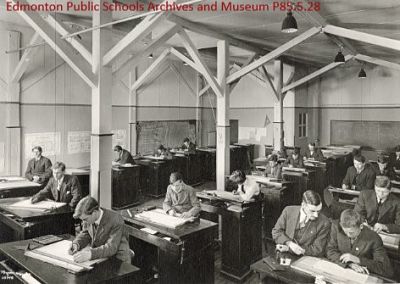
The Subject of Drafting
October 4 is World Architecture Day. Throughout history, the first step in creating a work of architecture has been the drafting of a plan. Drafting as a subject began in Division High Schools in 1947, however, it was taught even earlier in Edmonton Technical School. Our first picture is a drafting class at Edmonton Technical School circa 1913 - 1923.
Photo Credit: Edmonton Public Schools Archives and Museum P85.5.28
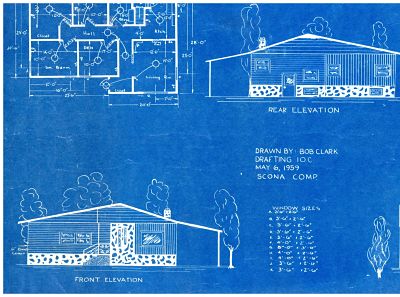
Blueprint of House [s] / Bob Clark. - 06 May 1959. - 1 architectural drawing : blueprint ; 33.5 x 59 cm. - The donor, Robert (Bob) Clark went on to become a Draftsman for Edmonton Public Schools in 1966. He retired from the District in 2002 as Director of Facilities Services. - Item is a blueprint drawn by the donor for a Gr X drafting class at Strathcona High School. It shows the interior and exterior of a house. - Title based on item. - Donated to Archives and Museum by Robert (Bob) Clark on 28 Jul 2011. - Description based on RAD 2008 revision. Created 08 May 2013.
Source Credit: Edmonton Public Schools Archives and Museum 2013.11.1
Fact #113
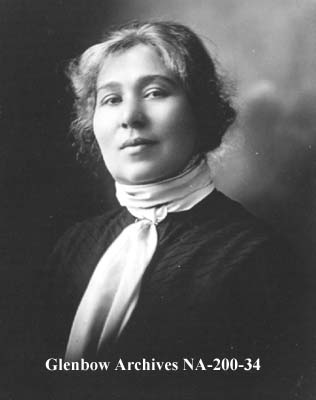
Bessie Nichols
In Canada, Women’s History Month is celebrated in October. During the month we will have several posts about women who have been trailblazers and are in some way connected to the history of Edmonton Public Schools.
When Bessie Nichols was elected as a Trustee of Edmonton Public Schools in 1912 she became not only its first female trustee but the first woman elected to public office in Alberta. Unfortunately, Miss Nichols was suffering from poor health at the time and it is unclear how many Board meetings she was actually able to attend. In 1913 she underwent two operations at the Mayo Clinic and in May of that year mailed her resignation to the Board who decided to grant her a leave of absence instead. It is believed she married in 1914 after her two year term ended. Bessie Nichols School, opened in 2012, is named in her honour.
Photo Credit: Glenbow Archives NA-200-34
Fact #114
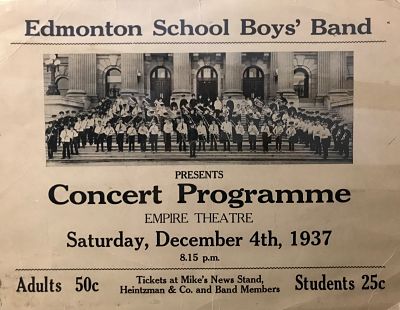
Edmonton Schoolboys’ Band
The Edmonton Schoolboys’ Band was founded in November, 1935 by T. Vernon Newlove, a teacher at Edmonton Technical School. Rehearsals began the following January in the Old Technical School. After four months, the forty-two original members played their first performance at an Open House for Edmonton Technical School. After several more school engagements, the band held its first concert, which was enthusiastically received.
In 1937 the band, now 100 strong, took part in the parade to honour the coronation of King George VI and gave a special concert in honour of the coronation.
Source Credit: Edmonton Public Schools Archives and Museum 86.131.2
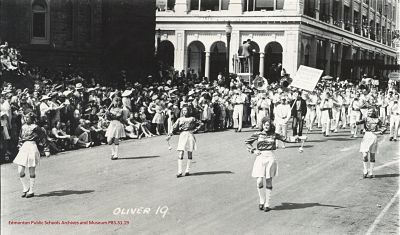
1939 was an exciting year for the band. The Calgary Gas Company paid for their trip expenses so they could honour an invitation to play at the Calgary Stampede. The band also played at the CNR station to welcome King George VI and Queen Elizabeth (Queen Elizabeth II’s mother) to Edmonton, on their cross Canada tour. It is believed that they were the only civilian band to play the Royal salute for Their Majesties on their tour.
Photo Credit: Edmonton Public Schools Archives and Museum P85.31.19
The band played regularly for the Edmonton Eskimos and Edmonton Grads. They were in big demand for parades, rodeos and building openings. The Edmonton Schoolboys’ Band gave their final performance in May 1969 in the Victoria Composite High School Auditorium.
Fact #115
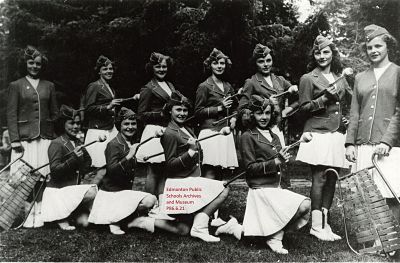
Edmonton Schoolboy’s Band Majorettes
In 1939 Vernon Newlove added majorettes to the Edmonton Schoolboys’ Band. They added flair to parades and often performed routines with their batons in front of the band at concerts.
On May 13, 1945 the band was scheduled to participate in a march past during the VE Day parade. Marshals would not allow girls to take part in the parade because of bylaws governing military events. Rather than seeing the majorettes excluded from the group, Newlove withdrew the band from the parade.
Community support for the band and the majorettes was so strong that the City Council was forced to change the bylaws in order to allow girls to take part in future military events. This ensured future participation of the band in military events as well as being another step in equality for women.
Photo Credit: Edmonton Public Schools Archives and Museum P86.6.21

Photo Credit: Edmonton Public Schools Archives and Museum P94.13.2
Fact #116
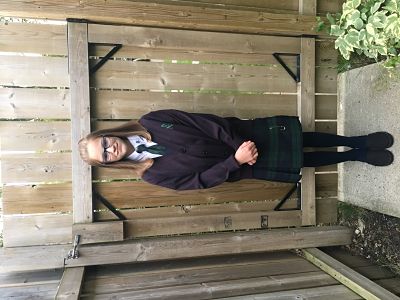
Nellie McClung Program
October 18 was Persons Day in Canada. It was on this day in 1929 that the British Privy Council (Canada’s Highest Court of Appeal at the time) ruled that women were indeed “persons”. Canada’s constitution at that time only used the word “he” when talking in the singular and therefore the men of the time used this to justify that women were not ”persons” and were not entitled to all the rights of men. The Persons Case, as it is known, was taken to the Privy Council by the lawyer for the Famous Five - a group of Alberta women pushing for equal rights for women. One of these ladies was Nellie McClung.
In 1995, Edmonton Public Schools launched the Nellie McClung program for junior high girls. This highly successful program, based at Oliver School, is focused on empowering girls to lead, challenge and change the world.
Photo Credit: former students of the Nellie McClung Program
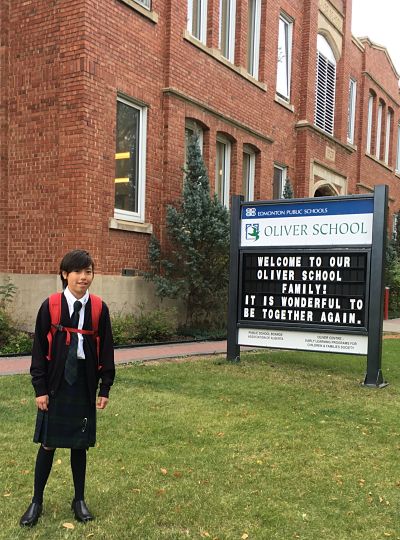
Fact #117
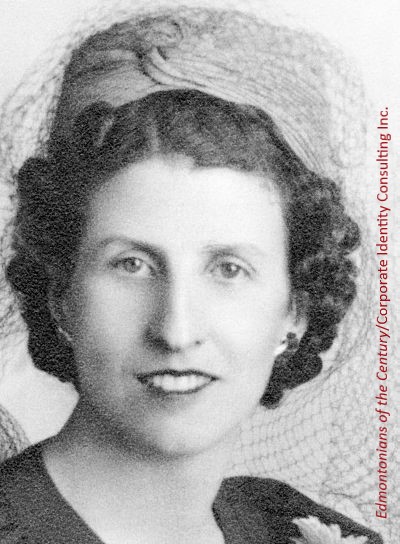
Women’s History Month & Velva Thompson
Velva Hueston was a teacher for Edmonton Public Schools at a time when female teachers, in accordance with board policy, were expected to resign as soon as they were married. In 1943 she married, becoming Mrs. Velva Thompson, but in a forceful letter to the Board indicated she had no intention of resigning citing that Section 246 of the School Act “does not permit any discrimination as between men and women”. When asked by the Board to amend the School Act the Province refused and the Board was forced to change its policy. Velva Thompson had won and remained on the School Board staff for a further two years when she retired to raise her daughter. She returned to teaching in 1956 and taught for nine more years at Coronation and Westminster Junior High School.
As a result of her bold actions, the status of female teachers who married and wished to remain on staff was ensured.
Photo Credit: Edmontonians of the Century/Corporate Identity Consulting Inc.
Fact #118

Women’s History Month & Roberta MacAdams
Roberta MacAdams moved to Alberta in the early 1900s and worked with rural women teaching home economics and surveying their needs. Her work led to the creation of the Alberta Women’s Institutes, a support network for rural women.
In 1912, she was hired by Edmonton Public Schools as Supervisor of Household Science.
In 1916, she was commissioned as a lieutenant in the Canadian Army Medical Corps and oversaw the production of over 3500 meals a day for patients and staff at the Ontario Military Hospital in Orpington, England. In 1917, she was elected to the Alberta Legislature as a member at large representing Albertan soldiers and nurses serving overseas. She was the second woman elected to the Assembly, after Louise McKinney who was elected in the same election.
MacAdams became the first woman in the British Empire to successfully introduce and pass a piece of legislation, the "Act to Incorporate the Great War Next-of-Kin Association."
In 1921 she moved to Calgary with her husband and son where she continued to work with women’s and educational organizations until her death in 1959.
In 2016, Edmonton Public Schools opened Roberta MacAdams School named in her honour.
Photo Credit: Roberta MacAdams School website
Fact #119
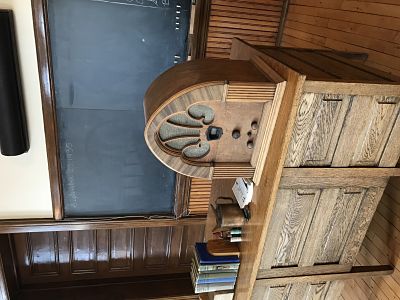
Technology in the Classroom - Radio
Today it seems hard to imagine that at one time radio was the latest in technology, however this is indeed the case. In the early 1930s, radio was being used as a teaching aid in the classroom using local radio programs, the most popular subject being Music.
Photo Credit: B. Christy
Philco Superheterodyne 90 Radio which was popular in the 1930s.
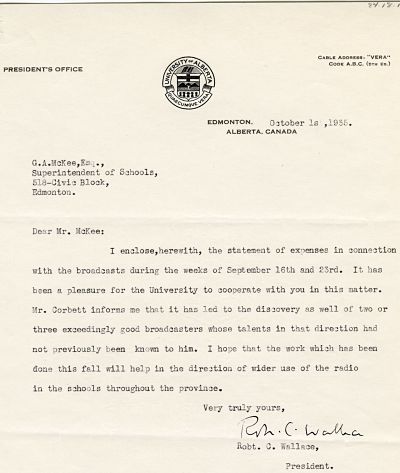
Just as today’s technology has been a tremendous, if not vital, asset during the current pandemic so was radio during an epidemic of 1935. We believe that this was the polio epidemic of 1935 as schools were closed during September of that year to help stop the spread of this highly contagious and often deadly disease. Information at Edmonton Public Schools Archives and Museum indicates that “lessons were broadcast on the University of Alberta Radio Station, CKUA. Broadcasts were made when the schools were closed due to an epidemic.”
Source Credit: Edmonton Public Schools Archives and Museum 84.18.1
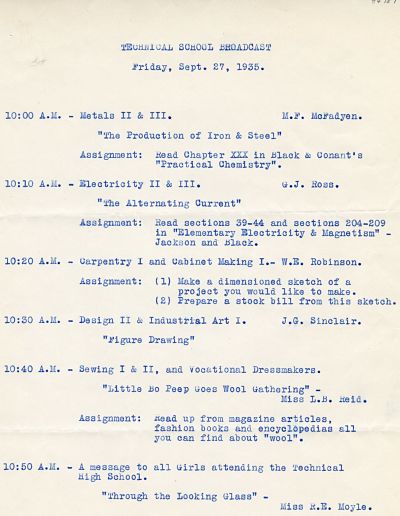
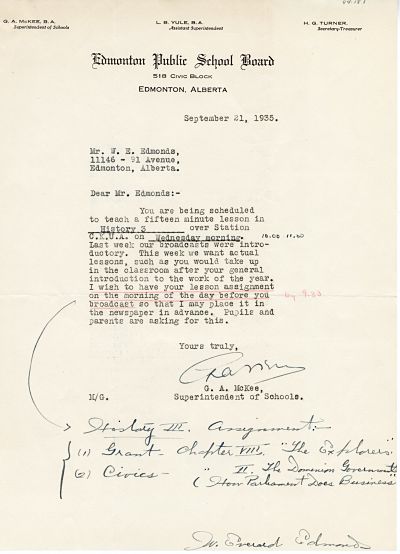

Fact #120

Technology in the Classroom - Television
Following radio, television was the next big technological innovation in the classroom. In 1954, television experiments were recommended to the Board. In co-operation with CBC and the Department of Education, four schools were selected to participate in a television project to determine the future usefulness of the media as an instructional tool.
The 1959 Educational T.V. programs were made available for public viewing over CFRN-TV as well as for classroom use. Master teachers projected a series of daily lessons in science, social studies and spelling to selected classes during March.
On Oct 9, 1973, Trustees voted unanimously to allow television stations to televise Board meetings. The first meeting to be televised was the organizational meeting of October 23, 1973.
Pictured are students, at an unidentified school, viewing television in their classroom in 1970.
Source Credit: Edmonton Public Schools Archives and Museum 85.19.36
Fact #121
Technology in the Classroom - Computers
The first mention of the possible use of computers in Division schools appeared in the 1966-67 Edmonton Public School Board Annual Report. It states that the Trustees approved the planning and acquisition of an IBM Model 30 computer for accounting and statistical records; this would also be the first step towards the use of computers for instructional purposes.
Computer terminal experiments were initiated at Jasper Place Composite High, Hillcrest Junior High, McDougall Elementary-Junior High and Richard Secord Elementary in 1970. The project, funded by Alberta Human Resources Research Council, IBM Canada, and the University of Alberta, was to determine which curricular area might benefit the most from the use of this new technology.
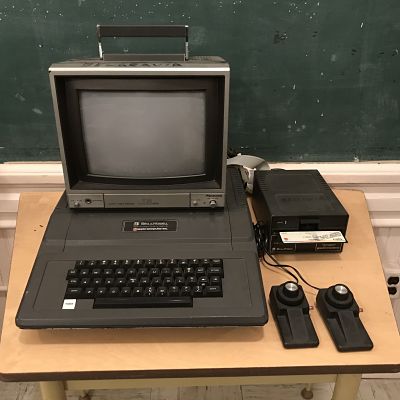
Pictured is a Black Apple II Plus computer produced in the 1980s. The black version of the Apple II Plus was made exclusively for Bell & Howell for sale to educational institutions.
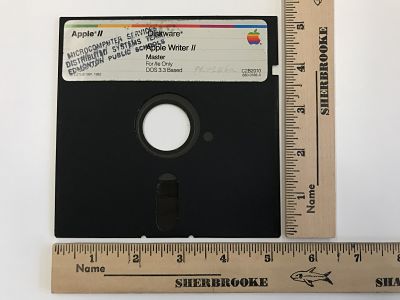
Data was stored on a 5.25” floppy disk. The highest capacity floppy disk made was 1.2MB. A 128 GB smart phone holds the equivalent data of over 106 thousand floppy disks!
![]()
Photo Credit: B. Christy
Source Credit: Edmonton Public Schools Archives and Museum 94.79.1
Fact #122
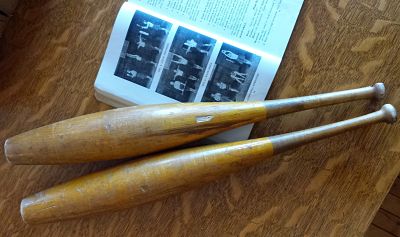
Physical Education - Indian Clubs
When the British came across exercising clubs in India, during the 1800s, they named them Indian clubs. During the British colonial period, the officers made note of the use of the clubs as a total body workout. They were used by a group of exercisers, led by an instructor, in a series of synchronised movements.
Photo Credit: B. Christy
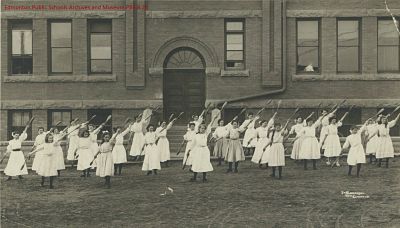
The clubs eventually made their way to North America and into schools’ physical education programs. This is a group of McKay Avenue School girls taking part in Indian Club training in the early 1900s.
Photo Credit: Edmonton Public Schools Archives and Museum P85.8.20
Fact #123

Physical Education - The Early Years
In 1890, calisthenics was added to the curriculum of public schools (Standards I - IV or Grades 1-8). The province announced a new physical culture program in 1907, with physical training continuing to be the focus. Today’s photograph is of the McCauley School Junior Girls Physical training class in May 1920. A girl in the front row holds the C. K. Flint Trophy. This was the first year the trophy was awarded by The Edmonton Journal to the Junior Physical Training class that received the highest mark in an annual competition within Edmonton Public Schools.
Photo Credit: Edmonton Public Schools Archives and Museum P85.14.3
Fact #124
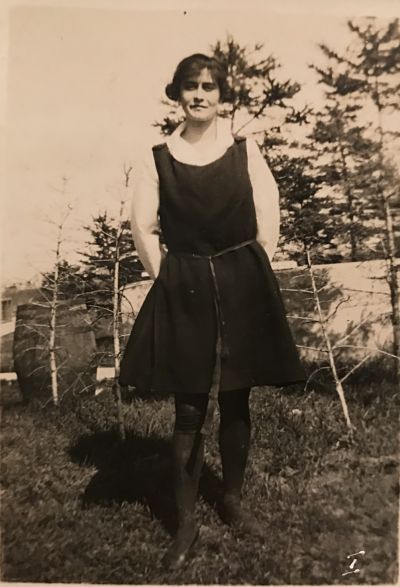
Physical Education Uniforms Over the Years
Gym attire for students has changed over time; most notably for girls. Our first image is Edith Chauvin, “physical instructress” at Victoria High School in 1920.
Photo Credit: P88.4.15

The second image is the required Phys. Ed. uniform for girls in junior and senior high school from 1949 to the late 1960s. It was adopted as girls could not wear slacks to class. The required uniform for boys at this time was a plain white T-shirt and royal blue shorts with a white side stripe and elasticized waist.
Photo Credits: B. Christy
Fact #125

Formation of School Cadets
Pictured is the Edmonton Public Schools’ Cadet Battalion of 1910. The cadet movement began in Eastern Canada after the American Civil War and the Fenian Raids. The movement spread to Western Canada in the 1890s as a result of the $50 incentive grants provided to schools forming cadet corps. The first recorded history of a military cadet drill in an Alberta school was documented in 1895, at the old Central School in Calgary. Organization of a Calgary School Cadet Corps was formalized in 1904.
Three years later, in 1907, in response to a petition from the students of the Edmonton High School, it was decided by the Edmonton Public School Board to organize three cadet companies. One company was organized at College Avenue School (Edmonton High School), one at McKay Avenue School and one at Queen’s Avenue School. The High School Company, designated “A” Company, was organized by Captain C. K. Flint on December 20, 1907. By 1908, school companies were also active in Alex Taylor and Norwood Schools. On March 12, 1908, the Edmonton Public School Cadet Corps was entered into the records as Cadet Corps #180.
Photo Credit: Edmonton Public School Board Annual Report 1910 p. 12
Fact #126
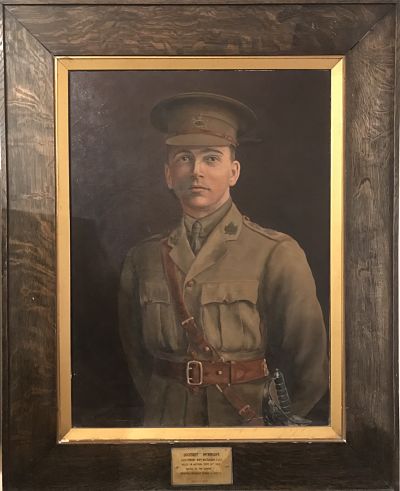
Remembrance Day
A portrait of Locksley McKnight is part of an exhibit on the main floor of Historic McKay Avenue School. Lieutenant Locksley McKnight, who left his position as principal of McCauley School to join the World War I war effort, was one of four Edmonton Public Schools teachers who did not return from the war.
We do not know how many Division employees joined the war effort; however, during the first six months of the 1916 school year 15 staff members, mostly teachers, had enlisted. A 1914-1918 Honour Roll lists the names of 109 high school students who fought in the Great War. It is unknown how many students died.
During the Second World War, 59 staff and 1400 high school students served with the Canadian Armed Forces. There were no fatalities amongst the staff members but sadly 115 students made the ultimate sacrifice.
On Remembrance Day 2021, we remember and honour the staff and students of Edmonton Public Schools, and all Canadians, who fought for our freedom.
Source Credit: Edmonton Public Schools Archives and Museum 97.92.1a,b
Fact #127
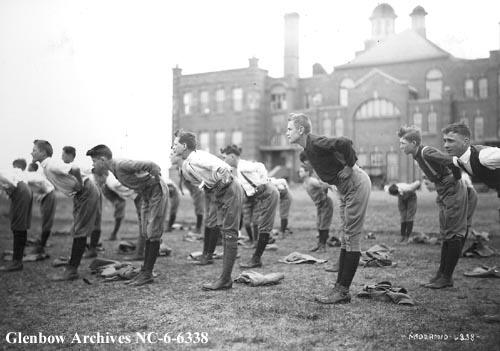
Cadet Training
Initially, school cadet training was incorporated into the new physical culture program announced by the province in 1907. Training included military squad drill practice, rifle drill and bayonet exercises. Target practice often included live ammunition, supplied by the Department of Militia and Defence. Participation in this military training was compulsory for all boys 12 years and older.
Although the military drill aspect of the physical culture course was designed for boys, girls received some very rudimentary training in marching and military drill as well. Most of the girls’ program, however, focused on gymnastics. Dumb-bell, wand, and Indian club drills, as well as outdoor basketball were also included in this new program.
Photo Credit: Glenbow Archives NC-6-6338
Fact #128

Cadets & Rifles
Today’s post shows officers reviewing cadets at Victoria High School in 1921.
One of the cadet activities that caused much concern to Trustees was target practice and the use of live ammunition by 12 year old boys. At the meeting of the Board on January 4, 1918, permission was granted to allow target practice inside the schools. In Superintendent Carpenter’s memo to principals the next day, he stated that permission was “granted to erect 4½ foot square targets in the Assembly Hall of city schools where the facilities in the basement made it impossible to get a 20 or 25 foot range for target practice.” Strict rules were also outlined. Targets were to be “filled with sand or soil and tightly boarded to prevent the spilling of the filling on the floor.” Practice was “not to be done during school hours and only in the presence and supervision of the teacher.”
Needless to say, target practice assisted in maintaining the interest of cadets in their work!
Photo Credit: Glenbow Archives NC-6-6333
Fact #129
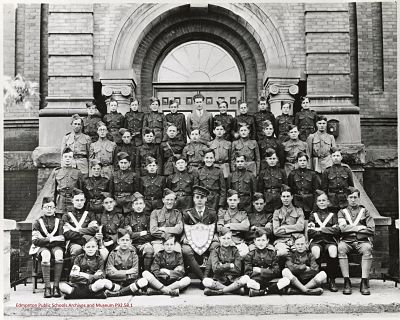
The End of the School Cadet Movement
Although enrollment in the cadet companies was increasing in the 1920s (2259 cadets in 1926) there was growing opposition to the movement. On March 17, 1927 the Board made cadet training an optional activity in Edmonton Public Schools. Only boys who had the permission of their parents could participate. Opposition still continued and on June 26, 1932 Trustee Sid Bowcott moved “for the elimination of present cadet military or semi-military training system at present carried on in the Edmonton Public Schools and High Schools.” The motion was carried and military training in Edmonton Public Schools was discontinued as of September 1, 1932.
Shortly after the outbreak of the Second World War, the Alberta Department of Education allowed senior high school students to obtain two high school credits by joining army, navy or air force cadet organizations, and taking military training out of school hours.
Photo Credit: Edmonton Public Schools Archives and Museum P92.53.1
McKay Avenue School cadets circa 1929 (believed to be the last group of cadets at the school)
Fact #130
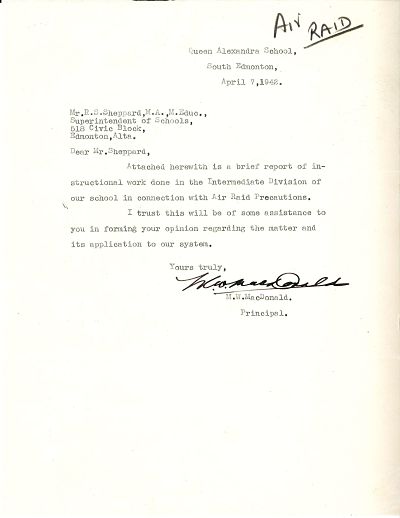
Air Raid Precautions
In March of 1942, arising from a suggestion by the Garneau Home and Schools Association, a project on “air raid precautions” took place with intermediate level students at Queen Alexandra School. The results were to be used as a basis of determining the feasibility of carrying such projects throughout the Division. Our image today is the cover letter of the three (3) page report sent to Superintendent Sheppard by the Principal of Queen Alexandra School, Mr. M. W. MacDonald, at the conclusion of the project.
It was reported that some of the information studied was the possibility of air raids, where such raids might come from, types of raids (sudden attacks or those preceded by warnings), what to do in each case, types of shelters and their use, composition of different types of bombs, what to do at school and at home, protection from flying glass, and first aid.
The report also indicated that “In the classroom drills were carried out to provide protection from flying glass. All students left seats and crouched down close to walls at the same time protecting their eyes with their arms. This was of course only for sudden attacks when pupils were to remain in their own room.”
For warnings given in advance of an air raid, the report suggested “pupils could be conducted from the school to their homes. For this purpose, teams of two pupils were assigned to go to other classes to assist teachers with organization and conducting pupils to their homes.”
Mr. MacDonald concluded his report by stating “I consider the experiment both interesting and worthwhile, and one about which I think every school could do something.”
Source Credit: Edmonton Public Schools Archives and Museum 85.120.249
Fact #131
Report Cards
For students in Edmonton Public Schools, November brings the first Progress Report. Referred to in the past as Report Cards, many of us will remember having them handed out at the end of the day with strict instructions from the teacher not to open them until we got home. These days are gone as today’s Progress Reports are prepared digitally and posted online on each student’s Schoolzone account at a preset time on a selected date. Today’s images illustrate how the Division’s report cards have evolved during our 140 year history.
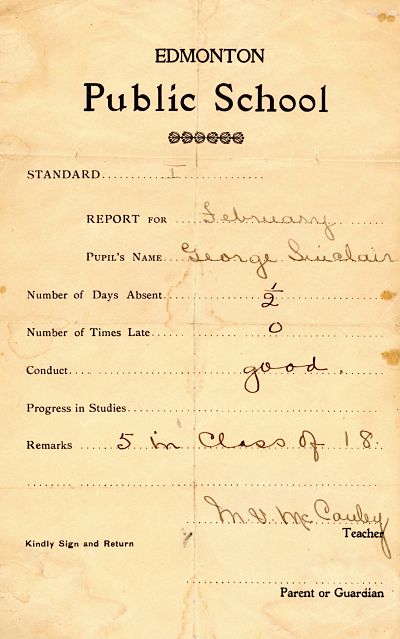
Standard I (now grades 1&2) February 1906. The oldest report card in our collection; yes, that was the whole Report Card! (93.159.1)

Edmonton High Schools Report of Standing 1939. Note the estimate of “homestudy” per week at the bottom of the report. (2013.16.21)
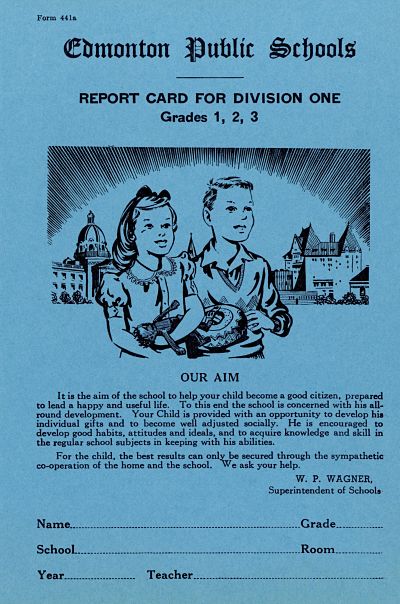
Edmonton Public Schools Division One: Grades 1,2,3 1955-1964. This was a true “card”. The back of the card (not shown) was for the parent signature. (85.23.6)
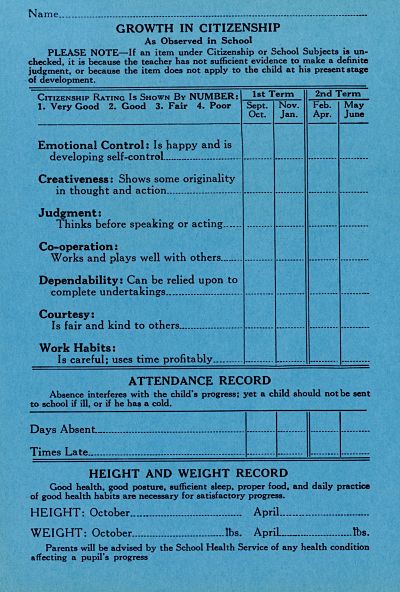
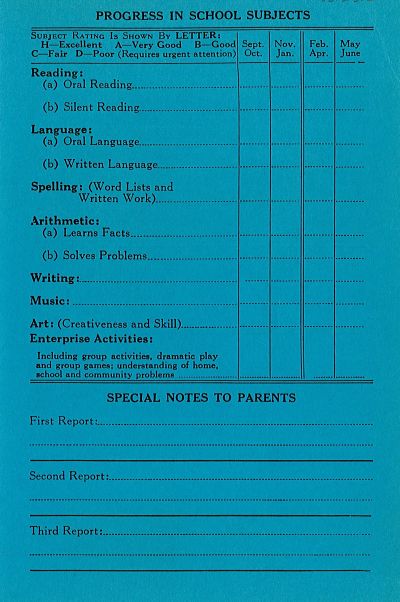
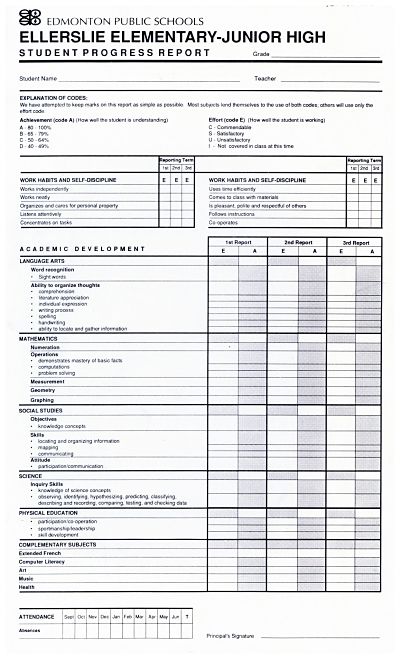
Edmonton Public Schools Ellerslie Elementary-Junior High 1991. A long single sheet with carbon copies. (93.121.69ii)
Source Credit: Edmonton Public Schools Archives and Museum Report Card Collection
Fact #132
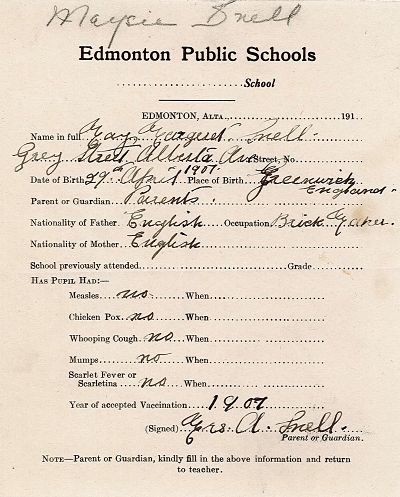
Registering for School
Today, when a parent wants to register a child to attend Edmonton Public Schools they fill out either a seven page online form or a six page paper form. In the past, parents filled a one page form.
Image 1 is a form filled out in September 1913 for Highlands School. Information from this form was transferred to an Enrolment and Attendance Record card (image 2) on the back of which was a Medical Inspector’s Record (image 3).

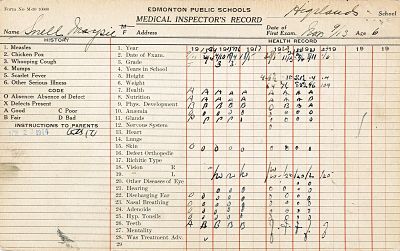
Edmonton Public Schools Archives and Museum houses these records dating as far back as the birth year 1896. These records can be a valuable source of information for individuals doing genealogical research.
Source Credit: Edmonton Public Schools Archives and Museum 95.69
Fact #133

Attendance Registers
Like Progress Reports, recording student attendance has gone digital. Today, teachers merely indicate each student’s attendance status daily on the computer. In the past, attendance was marked in the teacher’s Attendance Register.
At the end of each month the teacher was responsible for tallying each pupil’s attendance for the month (horizontal row) and the class total for each day (vertical column). The magic moment came if the total of the final column agreed with the total of the bottom row. If not, all the figures had to be recalculated until the tallies were equal. Registers were then sent to the office.
Pictured is an Attendance Register from Strathcona S.D. No. 216 of the North-West Territories Jan - Dec 1905.
Source Credit: Edmonton Public Schools Archives and Museum Attendance Register Collection
Fact #134

Class Size
It would appear that class size is not a new issue. While acknowledging that today’s classroom is likely far more diverse in its needs than in the past, it may come as a surprise to many just how large classes could be in the past.
In 1912, an attendance register (1st & 2nd images) from Highlands School indicated that Miss Scarth registered 73 pupils for a Grade 1 - 2 class. By November the enrolment had increased to 78! Enrolment at Highlands temporary schools was among the highest in the city at this time.

Source Credit: Edmonton Public Schools Archives and Museum Attendance Register Collection
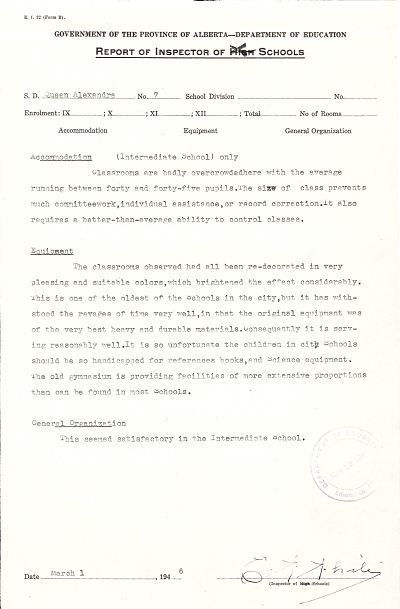
A Report of Inspector of Schools (3rd image) dated March 1, 1946 states that the Intermediate classes at Queen Alexandra School were “badly overcrowded with the average running, between forty and forty-five pupils.” It goes on to list problems caused by such overcrowding.
Source Credit: Edmonton Public Schools Archives and Museum 85.120.249
Fact #135

Corporal Punishment
Corporal punishment was used as a form of discipline and is documented as early as 1906 in Edmonton Public Schools. The By-Laws and Rules of Order 1910 issued by the Board on February 17, 1910 stipulated the proper use of a suitable strap. It was to be used in extreme cases and only after the approval of the principal. Each school was required to keep a record of corporal punishment giving date, student’s name, behaviour and number of strokes of the strap. Some of the recorded offences were impertinence, laziness, poor writing, talking, carelessness, fighting, blasphemy, truancy, disobedience, rudeness, swearing, running in room. Regulation #5 in the By-Laws and Rules of Order stated that pupils “shall go directly to and from school and shall be responsible to the teacher for their behaviour on the way to and from school unless accompanied by parents or guardians.”
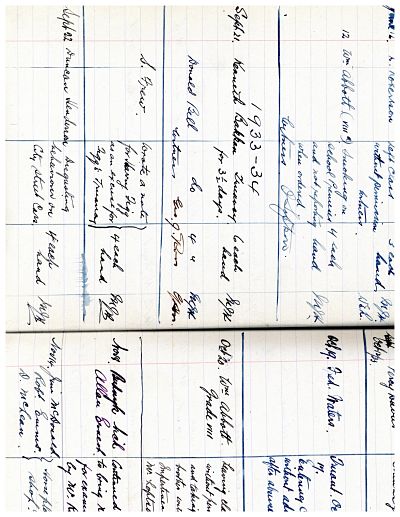
An Edmonton Technical School student received eight (8) strokes of the strap in 1933 for “disgusting behaviour on city street cars.” No details of the “disgusting behaviour” were given. (Image 2)
Source Credit: Edmonton Public Schools Archives and Museum 85.199.7
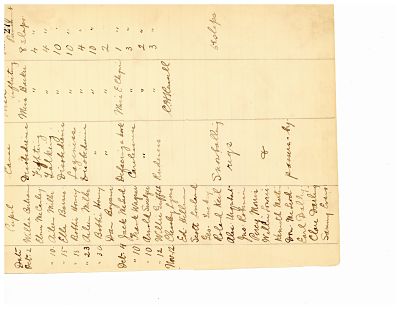
Snowballing on city streets was also a serious misdemeanour. On November 12, 1906, the headmaster of Queen’s Avenue School administered six (6) to eight (8) slaps of the rubberized strap to thirty-two (32) students of his school. All of the culprits were apprehended in the act of “snowballing rigs and passersby.” (Image 3)
One day in the 1930s, the principal of Westmount School, on one of his regular noon-hour patrols in the area, discovered several students marking up the sidewalk with chalk. As the principal always carried a strap with him, punishment was immediately administered . Upon arriving at school the next morning he was confronted by several angry parents waiting in his office. Much to his chagrin, he discovered that the young graffiti artists he had strapped were not Westmount students but students from a nearby Catholic school!
The use of corporal punishment was officially discontinued by Edmonton Public Schools in 1990.
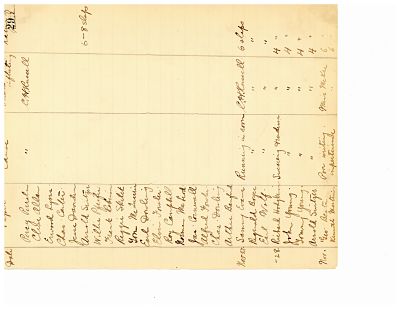
Source Credit: Edmonton Public Schools Archives and Museum 84.QA.1
Fact #136
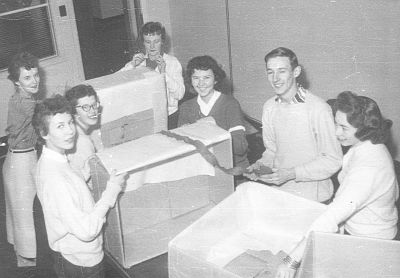
White Gift Campaign
During the 1950s and ‘60s, a few weeks before Christmas, participating Edmonton high schools would collect gifts from the student body ranging from foodstuffs to clothing to toys. These items would then be wrapped in white tissue. Students would also hold fundraisers to collect money to purchase perishables to add to the Christmas hampers. The gifts would be delivered by the students to needy families in time for Christmas. This annual Christmas event was called the “White Gift Campaign.” Pictured are students from Victoria Composite High School (Victoria School of the Arts) wrapping gifts in Dec 1958.
Photo Credit: Edmonton Public Schools Archives and Museum P2010.12.15
Fact #137
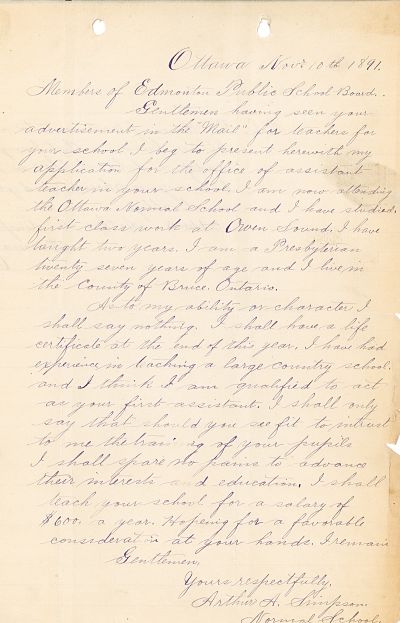
Teacher Application
Today’s image shows the oldest teacher application that we have in our records. It was made by Arthur A. Simpson on Nov 10,1891. He was applying for an assistant teacher position and asking for an annual salary of $600.
In the early years, teachers for Edmonton Public Schools were frequently required to reapply for their position. At this time they would also indicate the salary that they desired. In February of 1886, Richard Secord, who had been the teacher in the Edmonton School for almost 3 years and was earning $75 per month, reapplied for his position and asked for a salary of $80 per month. The job was given to William Carson who had submitted an application with a request for $75 per month.
Source Credit: Edmonton Public Schools Archives and Museum 84.9.1
Fact #138
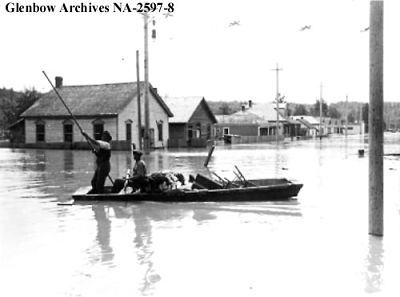
Archives and Museum - 1881 Schoolhouse Restoration
Following the construction of McKay Avenue School in 1904, the original Edmonton School was moved into the river valley to 9647-100 Street. It survived the flood of 1915 (Image 1) and remained at this location for over 70 years. It became the long-time home of the Mawhinney family in 1919.
Photo Credit: Glenbow Archives NA-2597-8
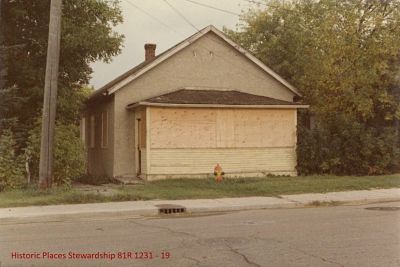
In 1980, the City of Edmonton purchased the home from the Mawhinneys. (Image 2 was taken at about this time.) The following year, this historic building was returned to Edmonton Public Schools for a token $1.
Photo Credit: Historic Places Stewardship 81R 1231 - 19
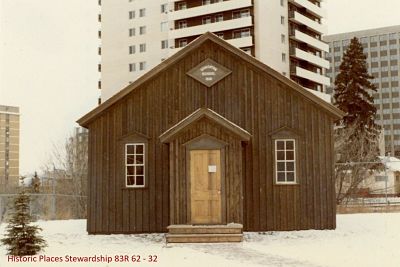
After much debate, it was decided to return Edmonton’s third oldest existing building to its original site. It now sits on the grounds of Historic McKay Avenue School within about 100m of its original location. After extensive restoration, the 1881 Schoolhouse (Image 3) reopened on September 25, 1982. One month later, on October 25, the schoolhouse resounded once again with the voices of students as teacher Michael Kostek welcomed Grade 5 students from Braemar School for a taste of education in early Edmonton.
The 1881 Schoolhouse continues to be a favourite field trip of students from Edmonton Public Schools and other jurisdictions. To date, just under 118,000 students have attended this student program.
After a pause at the beginning of the pandemic, we have been able to continue offering a late 19th century educational experience using early 21st century technology!
Photo Credit: Historic Places Stewardship 83R 62 - 32
Fact #139

Archives and Museum - Historic McKay Avenue School Restoration
On June 30, 1983, McKay Avenue School was closed as its enrollment had dropped to 59 students. Demolition of the building was never seriously considered as it had been designated a provincial historic site in 1976, having been the home of the first legislature of Alberta in 1906 and again in 1907. Pleased with public response to restoration of the 1881 Schoolhouse a year earlier, Edmonton Public School Board Trustees approved a motion to create an archives and museum in the building.
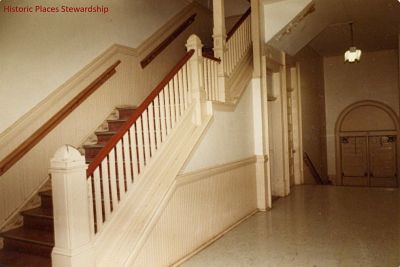
It would take far too long to give all the details of the almost five year process that resulted in the official reopening of Historic McKay Avenue School on April 29, 1988. Some of the highlights were:
Photo Credit: Edmonton Public Schools Archives and Museum

The majority of the restoration costs were covered through municipal, provincial, and federal grants as well as corporate and private donations. Students from a building construction class at W. P. Wagner School under the guidance of teacher Ron Massing restored two classrooms on the second floor as part of a work-experience project, saving a substantial amount of money.
Photo Credit: B. Christy
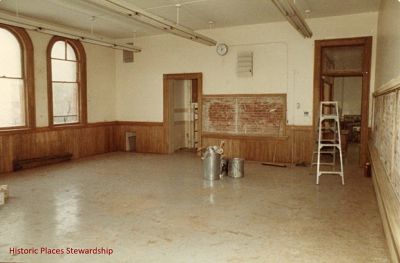
Photo Credit: Edmonton Public Schools Archives and Museum

In 1984 a great deal of work was accomplished by the hiring of students through Canada Works Projects and unemployed tradesmen through a federal Job Creation Project. Total matching grants of almost $900,000 was obtained from Alberta Education in 1986 leading to the hiring of an architect and contractor to complete the project. Restoration by Pentagon Construction began in January, 1987 and except for one pleasant interruption, continued for 14 months. On September 18, 1987 Governor-General Jeanne Sauve, while on a visit to Edmonton, participated in an outdoor rededication ceremony where she placed a time capsule above the original cornerstone laid by Governor-General Minto in 1904.
Photo Credit: B. Christy
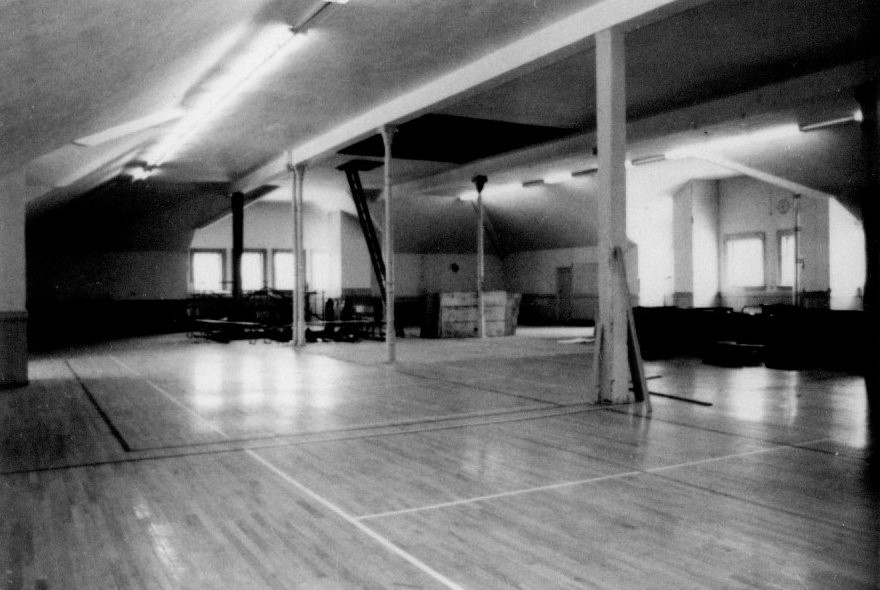
Photo Credit: Edmonton Public Schools Archives and Museum

On April 28, 1988 a special session of the Alberta Legislature took place in the newly restored Legislative Gallery on the third floor of Historic McKay Avenue School. This was to commemorate the 82nd Anniversary of the First Legislature of Alberta held at Mckay Avenue School.
On April 29, 1988 Edmonton Public School Board Chairman Dick Mather was Master of Ceremonies in an official ceremony for the re-opening of Historic McKay Avenue School. The main address at the ceremony was delivered by Her Honour, Helen Hunley, the Lieutenant-Governor of Alberta.
Images 2-6 are before/during restoration and present day pictures of: east staircase from main floor to second floor, 1912 classroom, third floor looking toward Legislative Gallery.
Photo Credit: B. Christy
Fact #140

Board of Trustees 2021
Today’s fact is number 140 in our “140 Years 140 Facts” project. As our first post of the project was the first Board of Trustees, elected in October of 1881, we thought we would finish with a photo of the current Edmonton Public Schools Board of Trustees elected on October 18 of this year. We would like to congratulate each of the Trustees on their election and to say how much we look forward to having them lead us into the beginning of Edmonton Public Schools next 140 years.
Photo Credit: Edmonton Public Schools
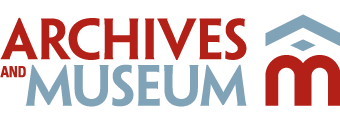























.jpg)
.jpg)
























































































































.jpg)
.jpg)
.jpg)



.jpg)

.jpg)
.jpg)
.jpg)
.jpg)
.jpg)
.jpg)
.jpg)
.jpg)















.jpg)






























































